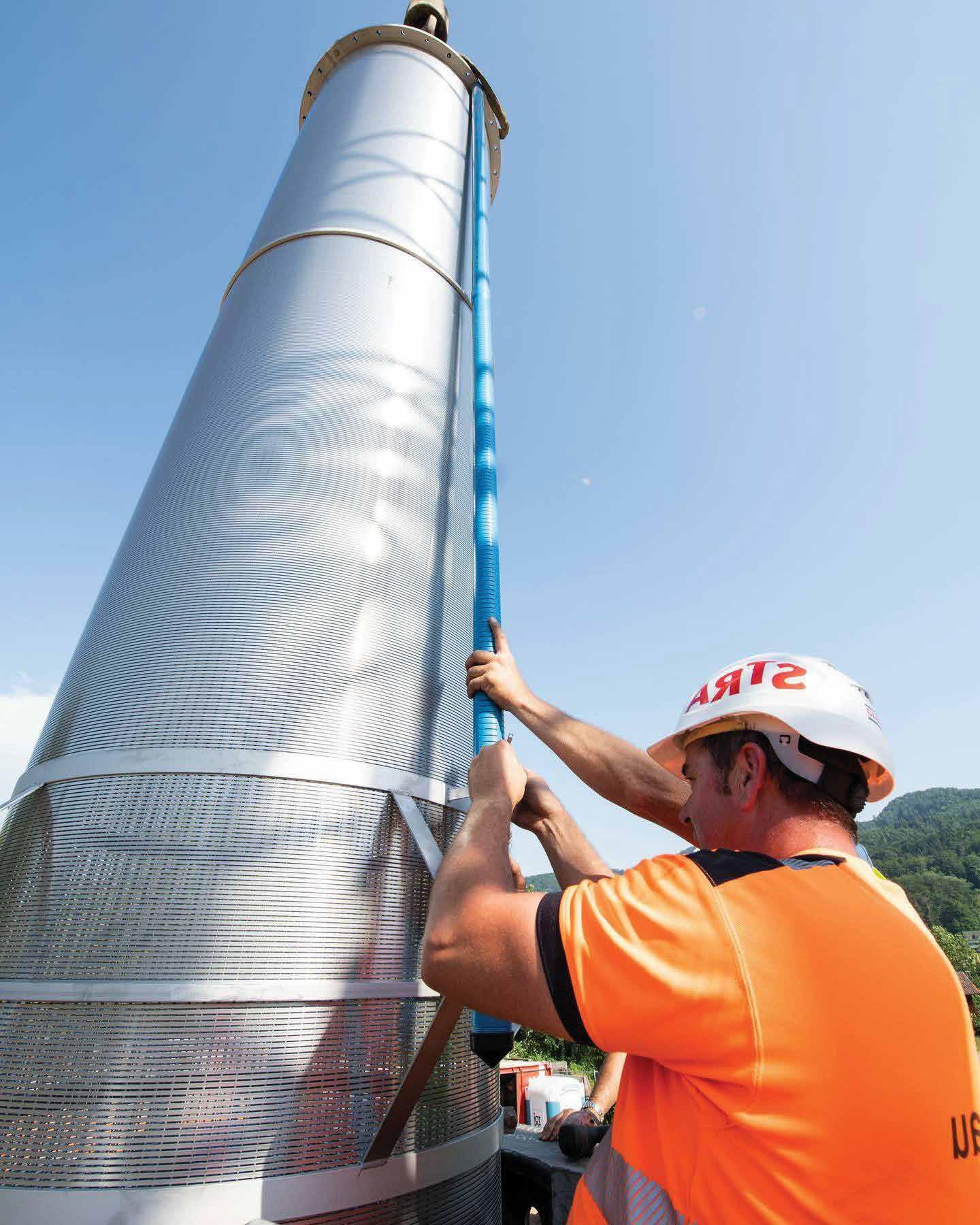



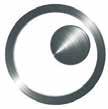
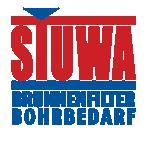














Hear first-hand from an unprecedented line up of Ministers and mining CEOs TOP SPEAKERS CONFIRMED SO FAR INCLUDE: See the full list at www.miningindaba.com #MI2023 BOOK BY 1 FEBRUARY FOR YOUR LAST CHANCE TO SAVE! 6-9 February 2023 CTICC, Cape Town
Hon. Gwede Mantashe Minister of Mineral Resources & Energy Republic of South Africa
Duncan Wanblad Chief Executive Anglo American Group Mark Bristow CEO Barrick Gold
Hon. Lefoko Maxwell Moagi Minister of Mineral Resources, Green Tech & Energy Security Republic of Botswana
Andre de Ruyter CEO Eskom
Benedikt Sobotka CEO ERG Resources
Hon. Paul Chanda C. Kabuswe, MP Minister of Mines & Minerals Development Republic of Zambia
Sinead Kaufman Chief Executive – Minerals Rio Tinto Rohitesh Dhawan CEO ICMM
Hon. Dr Abdirizak Omar Mohamed Minister of Petroleum & Mining Somalia
Tom Palmer President & CEO Newmont Corporation Roger Baxter CEO Minerals Council South Africa
Cover Image:
Carl Hamm’s Turnkey Dewatering Solutions for African Mining Projects
COVER STORY: PG36
Effective Dewatering, Compliant and Productive Mining
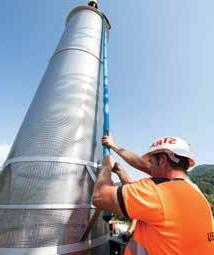
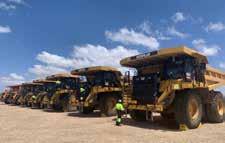
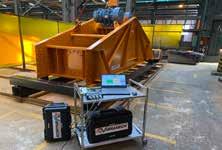
Carl Hamm Pipes Pumps
Solutions is committed to delivering the best possible customised turnkey dewatering solutions to solve challenges that mining companies face on-site as they are increasing output. Carl Hamm’s involvement helps mining operations focus on their core business and rest assured about high quality and backup service.
Editor
Nick Barnes
editor@miningbusinessafrica.co.za
+27 10 055 3356
Web/Sub-Editors
Jimmy Swira
Jimmy@miningbusinessafrica.co.za
+ 27 10 055 3356
Anita Anyango
anyangoanita18@gmail.com
Contributing Writers
Chantelle C.
chantellec@miningbusinessafrica.co.za
+ 27 10 055 3356
Editor’s Note

The devil is in the missing details
For those not in the know, South Africa has made the installation of Collision Avoidance Systems (CAS) on mining vehicles compulsory. This follows the approval by the Department of Mineral Resources and Energy (DMRE) gazetting of Level 9 Vehicle Intervention Systems for Collision Avoidance in Mining (read a concise article inside this edition).
As expected, advocates of safety in mining such as unions and advocacy groups have lauded the move, almost running short of superlatives. But the trend of laws designed to promote safety in the mining sector is a source of great concern. Typically, the laws are passed with much fanfare and not adequately enforced. A case in point is the persistent problem of acid mine drainage in Johannesburg and surrounding areas.
Generally, there is a perception that regulations are flouted with giddy abandon and culprits get away with murder or go scot-free. And how does the regulator react?
At best, the offenders get a fine that is only a slap on the wrist; at worst, nothing is done. In the end, they continue breaking the law with impunity, safe in the knowledge that they will not face any dire consequences.
Now, the question is whether the DMRE will mobilise enough resources to ensure the legislation on compulsory usage of CAS, and crack the whip.
Small wonder, analysts are curiously observing how the Department will enforce compliance. Currently, this is yet to be outlined, as they say: “The Devil is in the Missing Details.“
Nick Barnes editor@miningbusinessafrica.com

Susan M. susanm@miningbusinessafrica.co.za
Sales and Marketing
Winnie Sentabire winnie@miningbusinessafrica.co.za
+27 83 530 6832 | +27 10 055 3356
Angeline Ntobeng
angien@miningbusinessafrica.co.za
+ 27 078 322 5938
+ 27 010 055 3356
Accounts Precious Chirunga accounts@miningbusinessafrica.co.za



+ 27 10 055 3356
Art Director/Layout
Augustine Ombwa
Arobia Creative Consultancy

austin@arobia.co.ke
+254 772 187 334
Circulation/Sales info@miningbusinessafrica.co.za

+ 27 10 055 3356
Published By Media Icon (Pty) Ltd


38 42 02 CONTENTS January - February 2023 Media Icon (Pty) Ltd makes every effort to ensure the accuracy of the contents of its publications, but no warranty is made as to such accuracy and no responsibility will be borne by the publisher for the consequences of actions based on information so published. Further, opinions expressed are not necessarily shared by Media Icon (Pty) Ltd. www.miningbusinessafrica.co.za
TEAM
18
Investing in African Mining Indaba 2023 Special Edition

Unlocking African Mining Investment: Stability, Security, and Supply
Simon Ford, the Portfolio Director of Hyve Group, fields questions from Mining Business Africa (MBA) on the relevance of the 2023 Investing in African Mining Indaba’s theme to contemporary trends in African mining, as well as the in-person events.
MBA: After a two-year hiatus, the Investing in Mining Indaba returned in 2022. How is the mining industry’s response to this year’s event?
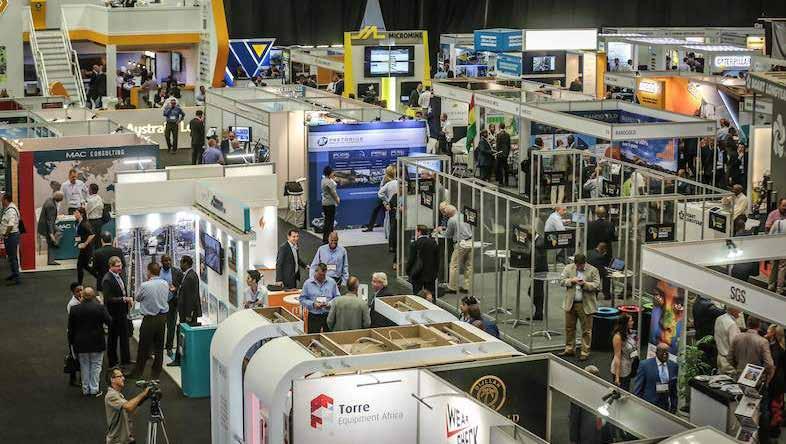
SF: Overall, the response has been extremely positive. We saw a record-breaking Indaba in May 2022 that set the tone for the industry and for post-pandemic events as we lead up to February 2023. We are seeing a lot of early commitment and we are encouraged by the interest we have already received. With commodity prices remaining strong, and demand for critical minerals, battery metals and rare earths accelerating we can expect this to translate to another bumper turnout and we are excited to be back to our regular dateline in February.
MBA: What changes have you introduced to ensure that the event meets delegates’ expectations and is more relevant to the current trends in the global mining sector?
SF: It is wonderful to be able to gather, once more, in Cape Town for the world’s largest mining investment event and as always, we are hoping for a blockbuster lineup of speakers, including key government leaders and policymakers, corporate leadership, investors and thought leaders. With the Mining Indaba’s integration of 121 Group, we are in an even stronger position to serve our thousands of delegates with bespoke meeting programmes between investors and junior miners as part of their Mining Indaba experience.
2 Mining Business Africa | January - February 2023 FEATURE
A beehive of activity at the 2022 event
The President of Zambia, Hakainde Hichilema, giving a keynote speech in 2022
One particular programme we are excited about for 2023 is the Explorers Showcase, where we hope to showcase early-stage explorers through presentations and core samples to help stimulate those much-needed conversations with investors. This ensures we can now claim to be driving investment into every stage of the mining production cycle through explorers, to juniors and on to mid-tiers and major mining companies.
It’s a great initiative, supported by the Department of Mineral Resources and Energy, South Africa, and will also help to support their exploration drive. To complement this, we will run the Junior ESG Forum as well as our ESG Awards. Please also look out for our new dedicated area for Junior Miners, aptly named the Junior MINE.

For the first time in 2022, we held our dedicated Infrastructure & Supply Chain Forum bringing together the vital mining supply chain companies with senior mining executives to discuss ESG-focused solutions to Africa’s growing mining operations. Such was the success of that programme, we have integrated it with our technology-focused Mining 2050 stream, to create the new three-day InfraTech
Delegates
Mining 2050, Sustainability Day, Young Leaders Forum and the General Counsel Forum.
MBA: You have chosen the theme of ‘Stability, Security and Supply for the 2023’ event. What is the rationale behind this?
SF: As the world cautiously emerged from the global pandemic in 2022, we rightly focused on getting Africa’s myriad economies back on track. Whilst ESG, from investment to operations and social licence to operate, will continue to underpin the values of Mining Indaba, we find ourselves entering a new chapter in both pan-African and global economies. Therefore, February’s official theme will be: “Unlocking African Mining Investment: Stability, Security, and Supply”. This captures the very real geopolitical shifts and economic disruptions we are experiencing, which are providing pressure points – as well as opportunities – within African mining. Due to this situation, global economies are seeking the security of supply, especially for their energy transitions, as well as the raw materials and precious metals to bolster their economic power.


Mining Business Africa | January - February 2023 3
@ Indaba content platform looking at critical aspects of mining infrastructure, technologies and building effective supply chains.
will also benefit from our mainstay content streams during Indaba week including Main Stage, Ministerial Symposium, Intergovernmental Summit, Green Metals Day,
Leaders of some SADC countries graced the event with their presence
FEATURE
MBA: There has been an observation among some analysts, which is a bone of contention, that virtual events will replace the traditional ‘in-person’ format in the near future. What is your take on this? What do you think makes ‘in-person’ relevant for events of the Mining Indaba scale now and for a long time?
SF: One of the key disadvantages of virtual events is the lack of in-person interaction. For almost two decades now, the Mining Indaba has brought the mining community face-to-face. We know the industry thrives on being together, making connections and sharing information. That is not easy to replicate in a virtual environment.
In 2021 we ran Mining Indaba as a two-day, content-led event, which was a huge success under the circumstances. We secured over 6,000 registrations from around the world and
had three African heads of state give keynote addresses. In addition, we also ran our Mining Indaba Virtual Investment Programme in March 2021, allowing mining companies the opportunity to meet with global investors and continue to drive investment into African mining. There is no replacement for live events though and in May 2022 Investing in African Mining Indaba returned as an in-person event after two years and welcomed a record-breaking 6 570 attendees to the CTICC, in Cape Town, South Africa.

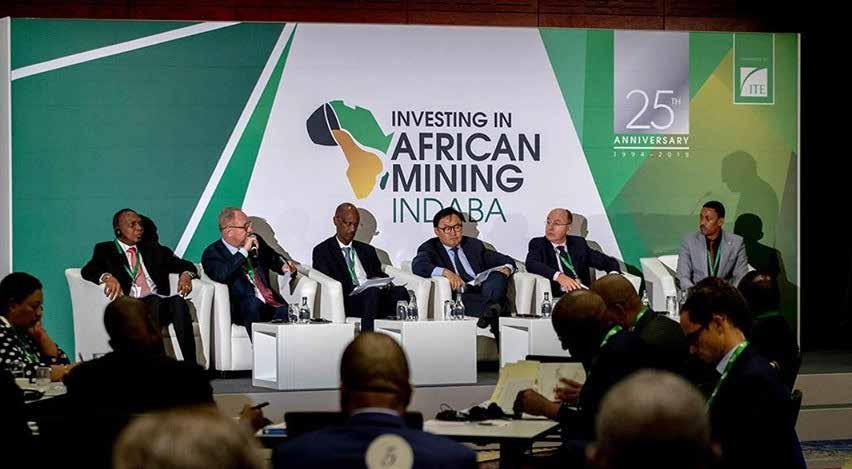
We are delighted to be returning to Cape Town in 2023 as a purely in-person event in its original February spot in the calendar from 6-9 February.
MBA: What opportunities or developments in mining do you see sustaining the hosting of events like Investing in Mining Indaba in the coming years?
SF: One of the most immediate benefits of hosting international events like the Mining Indaba is the impact it has on the local economy. It is often difficult to fully appreciate the economic impact of any major event so after the Mining Indaba in 2020 we worked with a South African research body, Stratecon, to conduct an in-depth report on the economic benefits of hosting the event in South Africa.
We found that Mining Indaba increased GDP in South Africa by R177m of which 80% was from international sources. We created 274 new jobs in South Africa, 233 of which were in the Western Cape and we helped increase national taxes by R22m, R18m of which was from international sources. So, the direct impact is certainly significant, and we are committed to increasing that further over the coming years by growing our events.
MBA: Last but certainly not least, what is your message to the delegates who will be attending The 2023 Investing in Mining Indaba as well as mining industry stakeholders?
SF: As the name suggests, Investing in African Mining Indaba has a core strategic remit focusing on bringing investment opportunities into the African continent. The conference provides a platform for mining majors, mid-tiers and juniors to discuss key industry issues. Mining Indaba also creates opportunities for exploration companies to network and engage with important investment stakeholders and government all under one roof.
4 Mining Business Africa | January - February 2023
A discussion on a topical issue at Investing in African Mining Indaba 2022
The use of Corflex Pinch Valves at the DRD Ergo Operations in South Africa

In 1978 the Anglo American Ergo Operation started on the eastern side of Johannesburg in South Africa for the recovery of pyrite containing gold, uranium and sulphur from old gold mines slimes dams of which there are many as mining of Johannesburg area has been going for many years.
Johannesburg is one of very few cities not built on a river. It was actually built on a river of gold extending +/- 150kms east to west.
The valves originally installed on the ERGO slurry pipeline was plug and ball types but these were found to be maintenance intensive. Many other valves were tried as alternatives including sliding disc valves a manual operated non-return ball valve and Corflex Pinch Valves.
Corflex Engineering was in the process developing high-pressure pinch valves for pipelines handling abrasive product. Pinch Valves are an ideal slurry valve as in the fully open position they are similar to a rubber lined pipe. When closed and not allowed to leak they can last for many years.

The Corflex Pinch Valve Sleeves originally had problems of failure due to pressure from water hammer but this was overcome by using stronger reinforcement for the rubber sleeve. To enable this special tooling was built. As the sleeves are hand-built Pressure testing of the sleeve for safety reasons was also started which is set at twice the maximum recommended
working pressure. Sleeve failure is in excess of three times the recommended working pressure.
In 1986 5 x 350mm Corflex Pinch Valves were installed in a major pump station at a pressure of 20 Bar. The flushing valves were eccentric plug valves. These proved to be maintenance intensive and later the manifold was lowered and 4 x 350mm Corflex Pinch Valves installed.
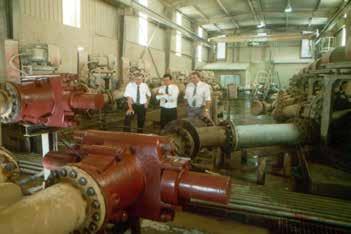
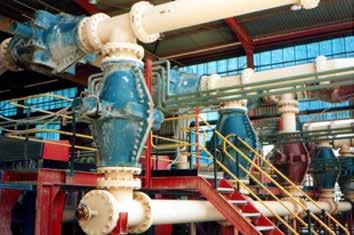
The pump station ran like this until it closed in +/- 2005. In 1988 Ergo Daggafontein and Simmergo operation was developed.

In 1988 the sleeve had been strengthened enough for 350mm Corflex Pinch Valves and 400mm on Pig Launchers to be installed on all Slurry operations for pressures up to 30 Bar (+/- 435 PSI) 200mm Corflex Pinch Valves were used to charge the pig launchers. The majority of ERGO pipelines were 450mm where the velocity was 1.9m/sec so the velocity through 350mm pinch valves was over 3m/sec.
Also supplied were 250mm for pressures up 40 Bar (+/- 580 PSI) and 450mm valves at 16 Bar (+/-232 PSI). This new operation increased ERGO slurry pumping to +/- 4,000 000 Tons per month. In 1990 two 300mm Corflex Pinch Valves were installed at a Booster Station at a pressure of 50 Bar (+/- 725 PSI). These two valves ran for 15 years with only one sleeve being replaced due to being punctured by a piece of metal as the valve was being closed.

Corflex Engineering (Pty) Ltd

Two 300mm Corflex Pinch Valves were installed on the inlet side of two banks of 8 Pumps for pressures up to 25 Bar (+/- 360 PSI). These valves had no failures. In 1988 Rand Mines developed the Crown Mines Operation to recover gold, uranium sulphur from slimes dams around Johannesburg and in the west. Corflex Pinch Valves up to 500mm were installed in all slurry applications up to pressure of 25 Bar. Both ERGO and Crown Mines continued to use Corflex Pinch Valves for all their slurry applications. In around 2005 Anglo American stopped its ERGO operation. This was subsequently taken over by Crown Mines. All equipment that could be salvaged including Corflex Pinch Valves were put back into use. There are many Corflex Pinch Valves of all sizes which have been operating in both operations since 1986 which to date is some 36 years. Most of the Corflex Pinch Valves are hydraulically operated because of high pressure. In some areas where fail safe is required the pinch valves automatically close and act as a non-return valve.
Corflex Pinch Valves supply Pinch Valves suitable for higher pressures than any other similar valve. The Corflex Pinch Valves have continued to show that they can safely handle high pressures with low maintenance for long periods of time on slurry pipelines.


Mining Business Africa | January - February 2023 5 FEATURE
Corflex Pinch Valves for high and low pressures in abrasive slurry applications.
Turning Risk into Competitive Advantage
“Mining companies can turn the risks that Environment, Social and Governance (ESG) issues pose on their operations into competitive advantage through improved reporting on key materiality factors which impact the sector, impact investors and all critical stakeholders. Active management of ESG reporting will translate into positive investor sentiment and ultimately into long-term sustainable returns. Credible data from reliable ESG ratings can support informed business decisions which, in turn, will allow sustainability to materialise into an invaluable asset. Data analytics provides management and the Board with a tool to assess its internal capacity and risk appetite, thereby allowing it to set its risk tolerance levels based on budget, available resources and strategy.”
Above represents a snapshot of the advice from the experienced team at Risk Insights (Pty) Ltd to mining companies in South Africa and in the region. The team is equipped with the first machine learning and Artificial Intelligence ESG sustainability rating tools - ESG GPS for rating listed companies and A-Cubed for unlisted companies. These tools provides a consistent, transparent and independent view of a company’s ESG readiness taking into account global best practice and specifics / regulation while presenting multidimensional by factor analysis on E, S and G.
Findings of the Ernst and Young Survey allay any misgivings – if they had been any - that mining companies in Africa may have had about the significance of sound management of Environment, Social and Governance (ESG) to the long-term sustainability of their operations. The survey, Top 10 Business Risks and Opportunities for Mining and Metals in 2022 Report, highlights that top global mining executives rank Environment, Social and government (ESG) as the number one amongst risks and opportunities businesses will face over the next twelve months. The results were drawn from data collected from a yearly survey involving over 200 global mining executives. Others in the top three are decarbonisation and Licence to Operate (LTO). Interestingly, LTO topped the list in the 2021 report.
The report resonates with the viewpoint of Mr Andrey Bogdanov, CEO of Risk Insights (Pty) Ltd, an international professional data science firm. Risk Insights has extensive experience and expertise spanning fields as diverse as capital markets, risk management and data science. The firm`s professional Data Science Lab uses cutting edge techniques and has built the first AI-powered machine learning ESG rating tool
for Africa by Africans. In 2020 and 2021, the company was awarded the prestigious World Economic Forum Awards, in 2022 company was recognised as Best ESG Data Provider in Africa by the Environmental Finance. Risk Insights provides ESG sustainability ratings to diverse clientele across the Globe.
Four aspects in reliable reporting
Risk Insights notes that ESG reporting is a relatively new requirement in South Africa as well as across the continent, although the mining sector, especially large blue-chip entities, have had ESG policies and reporting embedded in their operations for several years. For this reason, Mr Bogdanov says the firm is keen to utilise its Data Science Lab comprehensive data sets to address growing requirements of mining companies for international best practices in ESG reporting, their materiality disclosure and ranking within their respective peer groups to assist in positioning mining companies to fully materialise competitive advantage related to ESG as the world moves toward carbon neutrality. He is certain that, through comprehensive reporting, mines can formulate and implement strategies which will make their
operations more sustainable going forward. Specifically, he cites three fundamental aspects which can facilitate reliable ESG reporting: the leading role of the board and management (topdown approach); the business re-engineering process; and engaging experienced experts, as ESG is a complex subject matter.
• The board and management at the forefront ESG reporting must be empirical relevant, material, transparent and easy to track to be credible, and so, it is not surprising that it takes up more time and resources. Accordingly, Bogdanov recommends that, for ESG reporting to be more embedded in an organisation’s operations, its setup must follow both ‘top-down’ and a bottom-up approach. “ESG should be driven from the board and management level into the entire organisation and entrenched into the culture of a company while education needs to be provided to all levels in the organization,” says Mr Bogdanov, underlining a mindset change as a critical process, as it can determine the effectiveness of ESG’s aligned strategies and policies.
6 Mining Business Africa | January - February 2023
FEATURE
• Business engineering process
Successful ESG reporting relies on a rigorous business engineering process, which culminates into the change in the culture of an organisation. ESG affects several parts of an organisation’s value chain, to name a few, supply chain management and measuring carbon footprint Scopes 1, 2 and 3 (both direct and indirect emissions). Specifically, what is reasonable from four perspectives – the company, the industry and the employee and society. Certain processes within the mining company may be responsible for more emissions and therefore to assist reporting and impact the trade-off charts using data analytics for measurement and monitoring could differentiate one mining company against another.
Robust business engineering processes result in strong, transparent and effective reporting thereby mitigating risk and creating opportunity and competitive positioning. ESG reporting is translated in the integrated reports as well as voluntary and mandatory disclosure of companies.
• Engaging credible experts
Given the complexity of ESG and its impact on the various stakeholders and the value chain, engaging and employing specialists with a credible track record in the field is key. Hence, it is critical to engage specialists who can train, develop and educate on ESG matters and ensure embedding it into the organisation on all levels,” advises Mr Bogdanov. One of the risks that Risk Insights has noted in South Africa is a repurposed approach when it comes to appointing individuals on ESG related positions which have very little experience or training on ESG.

Core business imperative, not an option
Indeed, all told, the importance of sound ESG reporting in the current operating environment cannot not be overstressed as the world devises strategies to protect the planet and contribute towards carbon neutrality. Ongoing developments have rendered sustainability into a core business imperative, and not an option.
• Stakeholder accountability
Stakeholder capitalism is here to stay.
Increasingly, different stakeholders are holding mining companies accountable for environmental, social practices and governance (or malpractices). Sustainability became part of the day-to-day life in all forward looking companies positioning themselves for the new era of governance.
• Direct bearing on bottom-line
What makes ESG rating more relevant is its bearing on the bottom-line of a business. From a brand and reputation perspective, it translates into financial measurement through share price and market capitalisation. For instance, ESG scores can impact an organisation’s valuation. Impact investors apply larger discounts on companies that have lower ESG scores.
“Having a good ESG score means that a company embeds the principles of inclusivity and stakeholder management into its strategy, operations and human capital management making a company more sustainable. It translates, via brand and reputation management viewpoint, into a competitive advantage affecting the cost of capital and cost of debt of a company,” Mr Bogdanov points out.
• Positive legacy
Finally, by doing more to ensure the long-term, sustainable economic and social growth of the region in which they operate, mining companies can leave a positive legacy beyond the life of the mine.
Prioritising ESG more
By and large, the burden is on mines to turn the risks that ESG factors pose to their operations into competitive opportunities and positioning to demonstrate their commitment to sustainable business practices. Risk Insights would like to see “African leadership actively translate value as conscious leadership into good for current and future generations. Leadership must pivot to change the world and the ways we operate when it comes to CO2 emissions, water pollution, taking care of communities, inclusivity and much more. Mining is one of the closest to earth industries”.
Risk Insights has blazed a trail with Africa’s first machine learning and Artificial Intelligence ESG sustainability rating tools - ESG GPS and A-Cubed suites of products. So far, ESG GPS has been used to rate all listed companies in South Africa, Nigeria,Kenya and Mauritius. More markets to come in 2023.
Mining Business Africa | January - February 2023 7
Mr Andrey Bogdanov, Principal and Interim CEO of Risk Insights (Pty) Ltd, a Johannesburg-based boutique professional risk management data analytics firm
Sensor-Based Intelligent Mining Operation - Level 9 Collision Avoidance Systems
The leap to Level 9
‘Zero-Harm’ and maximum productivity is possible with Probe IMT’s integrated CAS solutions

Safer mining is about integrated risk management and safety protocols in a range of areas. Proximity detection and Collision awareness is a crucial focus area in the drive to reduce fatalities, contributing to the levels of protection against the risks associated with vehicle interactions on a mine. If implemented holistically, rapidly advancing proximity detection and collision awareness systems (CAS) create not only a safer, but also a more productive mine. This is thanks to advanced sensing technologies, sophisticated rules and intelligence and the wealth of data the systems are able to gather, analyse and feed back to the mine operators, says Gert Roselt, CEO of Probe Integrated Mining Technologies (Probe IMT).
Leading the way
South Africa is leading the way in the drive to implement the highest levels of collision awareness systems (CAS) to the Earth Moving Equipment Safety Round Table (EMESRT) Vehicle Interaction Defensive Controls Model Level 9 (intervention controls), where electronic systems automatically slow down the machine and apply a controlled stop if a dangerous interaction is detected when the operator has failed to take evasive action to the prior Level 7 (Operator Awareness) alarm and Level 8 (Advisory Controls) alerts. The mandating of Level 9 CAS for trackless mobile machines (TMM) in underground and surface mining in South Africa is now mooted for December 2023, as indicated by Dr Sizwe Phakathi, Head: Safety
and Sustainable Development at the Minerals Council South Africa, ahead of Electra Mining 2022. The International Council on Mining & Minerals (ICMM) aims to eliminate all fatalities from vehicle interactions in mining by 2025. Roselt highlights that collision avoidance ranked top of 13 different technologies identified by 47% of mines globally and 57% of mines in Africa as expecting to see significant investment in the coming two years based on the 2022 GlobalData survey. “With 30%-40% of mining industry deaths globally attributable to failures of vehicle interaction controls, this is no surprise. Advances in collision awareness are arguably already showing results - with one TMM related death reported this year to date in South Africa.”
8 Mining Business Africa | January - February 2023 FEATURE
The team leading the drive at Probe IMT
Major leap
The Level 9 standard is a major leap from Level 8, which required systems to deliver an advisory instruction to operators. Now, electronic systems must automatically take mechanical control of the vehicle and slow down and apply the brakes at any mine where there is a significant risk of such collisions. “Implementing reliable integrated systems that can comply with Level 9 requires long term commitment and solid investment in sophisticated CAS systems that provide high integrity object detection, operator warning and automatic intervention, when necessary, in order to prevent an accident,” says Roselt. “It must be far more than a box ticking exercise, with integrated technology implemented in a holistic way that avoids the challenges of operator alarm fatigue, sensing technology inaccuracies, unnecessary alarms during normal operations and reduced system availability – all of which can impact production.”
According to Roselt, if Collision Awareness solutions are implemented holistically, the data collected from multiple sensors related to the potential incidents drives enormous value for safety and productivity, especially when Artificial Intelligence (AI) and Machine Learning (MI) can be applied. For example, traffic flows can be managed and optimised to maximise production, he says.
“At Probe IMT, we have been working with carefully selected industry-leading solutions to help our clients ensure that they can meet the requirements of the Earth Moving Equipment Safety Round Table (EMESRT) Level 9 intervention controls using the mining industry developed ISO-21815 protocol.”
Wabtec’s value-added partner
Probe IMT is a value-added partner for Wabtec Corporation. “The Wabtec Collision Awareness Solutions Suite is a sophisticated and adaptable collision awareness and reporting system developed specifically for the mining industry with the aim of making mining operations safer, while helping to ensure optimal performance at a lower sustainable cost,” says Roselt. “Software algorithms that are able to interpret and anticipate the complex vehicle interaction scenarios presented during normal mining operations enables the Wabtec systems to operate seamlessly with the operator based on human centred design for new mining technology. Using advanced technology field hardware and communications software, with real-time system health monitoring and event reporting, the Wabtec Digital Mine’s safety technology provides industry-proven reduction in vehicle interaction risk. With the right reporting and analytics tools to monitor and manage operator behaviour, safety culture and compliance can rapidly be improved.”
The surface offering can be deployed with a variety of proximity detection methods including
GNSS, radio frequency (RF), VLF magnetic and cameras to provide one of the most effective high integrity systems on the market. The vehicle display unit includes touch screen HMI, with graphics display of remote objects showing ID, range, speed and heading with configurable audible, voice and visual alarms. Robust wideview cameras eliminate blind spots with auto switching on direction of travel and to zones of object detection. Further features include equipment health monitoring, maintenance tracking, blending, and production reporting.
A strong differentiator is the high integrity proximity detection using high accuracy GNSS augmented with time of flight (ToF) RF combined with real-time monitoring and connectivity provides 360˚ protection for vehicles, equipment and personnel. Strategically placed proximity units afford operators unparalleled situational awareness - contributing to improved safety levels on-site. Back-to-base reporting provides interaction reports, journey replay, hot-spotting, geofenced exclusion zones and alarm events, safety adherence reports and system health monitoring.
Roselt explains that this whole-of-mine safety aid is OEM independent as a stand-alone system. This means it is fully configurable and adaptable to site specific requirements, but still offers low total cost of ownership. CAS extensions can include integration with Driver Fatigue Monitoring Systems, Fleet Management / Dispatch Systems, machine vision and Asset Performance Management for mobile equipment.
Setting new standards
“We believe these solutions set new standards for workplace safety and facilitate ‘zero-harm’
objectives and productivity objectives through effective, reliable and intuitive operation,” says Roselt. “Ultimately, CAS Level 9 enables the safety of all personal in mines, and safer mines ultimately become more productive mines in the long run. Supported by robust and mature implementation of Levels 1-8, mines should carefully select implementation partners and technology to ensure a smooth transition.”
working around the globe. In a recent published blog by Ballard, that number of trucks emits 68 million tons of CO2 (MtCO2) each year, the same as certain countries such as New Zealand or Finland. Decarbonizing all those trucks would be like removing the impact of 150-million gasoline-powered cars off the roads.
If you are considering fuel cell vehicles, there are considerable benefits for mining’s off-road vehicles, according to Ballard. There are fewer regulatory requirements and certifications compared to on-road vehicles. Larger mining and construction companies may be able to reduce costs by ordering in quantity and leveraging economies of scale. Centralized hydrogen refueling can be built on site, and potentially renewable hydrogen can be leveraged on site to generate green hydrogen to be used as fuel for vehicles.
Certainly, those of us who are stakeholders in Africa’s mining industry can appreciate such efforts surrounding Africa’s hydrogen roadmap, and we look forward to hearing more about the hydrogen fueled haul truck as Anglo American’s experience with it can be relayed. In the meantime, as you may be contemplating just how hydrogen can play a role at your operation, it’s clear that the electrolyser choice is an important place to begin.
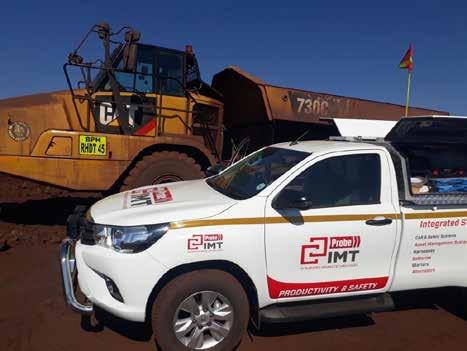
Mining Business Africa | January - February 2023 9














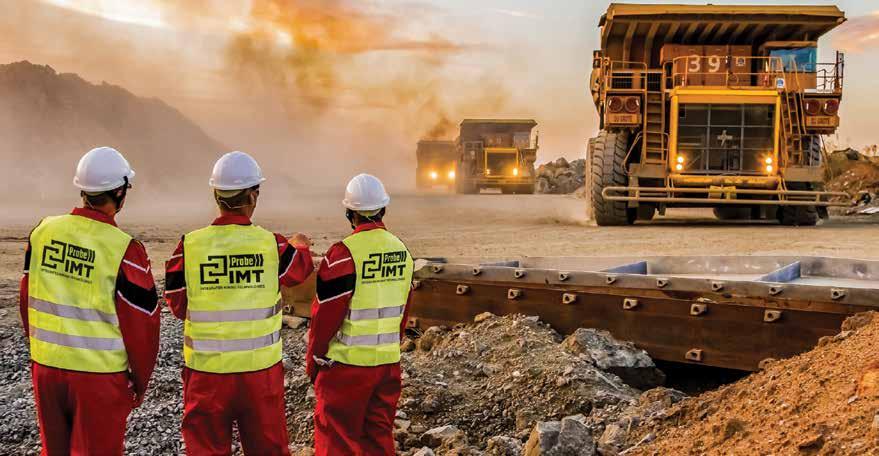









Spill Control - Environmental Protection, Health and Safety in Mining
Sound Spill Control, Compliant Operations
Accidental releases of oils and chemicals make up a large number of pollution incidents that occur each year on mining sites. Fortunately, many spillages can be prevented. However, everyone on site must know how to control a spill to minimise its impact. Thus, bearing this in mind, Spill Doctor advises mining companies on the best practice in spill control.
An increase in the spillage of hazardous oils and chemicals on sites is inevitable as mining companies are pulling out all the stops in endeavouring to increase productivity. However, the biggest concern is whether or not they are well-equipped to manage the safety risks that this poses to both their employees and the environment.
The reality is that sound spill control cannot be overlooked.
The obligation of legislation
In all countries, various pieces of legislation obligate mining companies and other industries to ensure that they adopt and rigorously implement measures to mitigate the impact of their activities on their employees and the environment. And South Africa is no exception.
In particular, South Africa’s Occupational Health and Safety Act of 1993, requires employers to bring about and maintain, as far
as reasonably practicable, a work environment that is safe and without risk to the health of the workers. Specific to mining companies, the Mine Health and Safety Act (MHSA) applies.
Raising awareness
Given the potential increase in spillage of flammable liquids, Spill Doctor has intensified its drive to raise awareness amongst mining companies about the best practice in spill control (the management of flammable liquids). In this way, the company aims to enable mining companies to achieve compliance with legislation.
Extensive experience and relevant products
As environmental, health and safety specialists, Spill Doctor is eager to address the unique needs of clientele in the mining sector. This is based on extensive experience accumulated from years of effectively addressing complex spill management challenges for clientele drawn from diverse industries.
Spill Doctor’s team are thoroughly versed in the management of stubborn flammable chemicals. This is above and beyond the company’s wide range of relevant products.

What is most noteworthy for clientele about Spill Doctor’s range of internationally compliant products is that it is handy, Kelvin Murphy, Head of the Team at Spill Doctor, states. “Our flammable cabinets, safety cans, plunger cans, oily waste cans, drums and dispensing equipment offer FM-approved products along with an exclusive 10-year limited warranty. The products support clients in the mining sector to reduce the risk of fire, employee injury and environmental damage caused by incorrect storage of flammable liquids. Generally, our products include “everything the client needs” to store, distribute and remove flammable liquids in a safe and legally-compliant manner. We have worked extensively to obtain exclusive
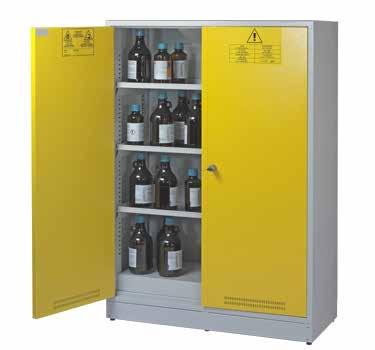
12 Mining Business Africa | January - February 2023 FEATURE
Some of Spill Doctor’s range of internationally compliant products
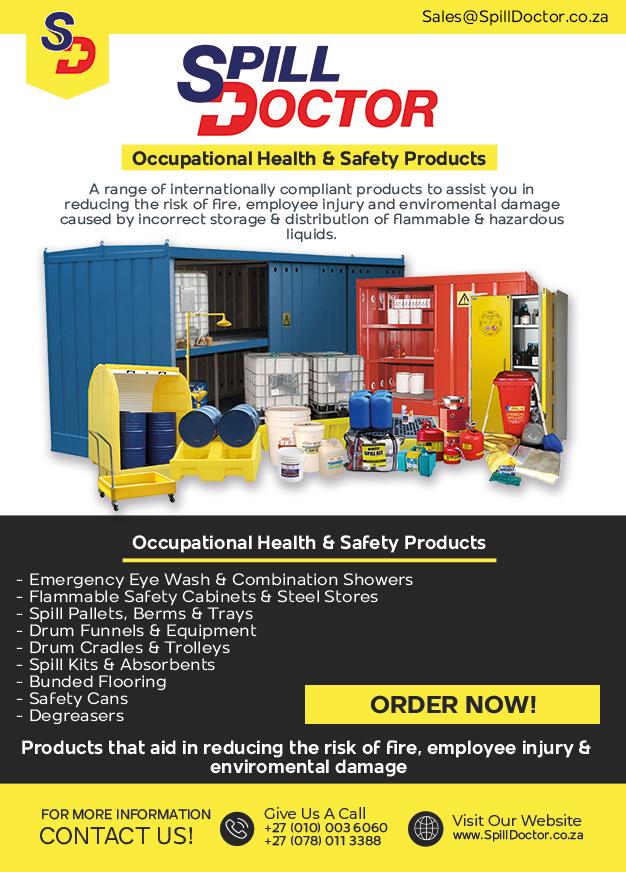
FEATURE
distribution rights in Africa for internationally recognised brands in the health, safety and environmental fields. “
To cater for the unique needs of clientele, Spill Doctor has products specific to occupational health and safety, as well as environmental management.
• Occupational health and safety
Spill Doctor’s extensive range of occupational health and safety products includes spill pallets, non-combustible flammable stores, flammable safety cabinets, eyewash stations and combination showers.
Spill doctor’s range of environmental products for spill control, spill containment and spill kits offer compliance with local environmental regulations and a five-year guarantee on polyethene products.
• Environmental management
Spill Doctor has tailor-made its environmental products cognisant of the importance of sound environmental impact mitigation practices in mining environments. “Although our main focus is on minimising risks and prevention of incidents, we understand that environmental spills do occur. That is why we are the distributors of a full bio-remedial range of products to repair damaged areas,“ Murphy says, guaranteeing that the products meet both local and international regulations regarding the safe storage, distribution and general usage of flammable and ignitable liquids.
Proactive Spill control
As a provider of storage solutions that assist clients in safely storing dangerous substances, Spill Doctor is unrelenting in urging mining companies to follow the best practice in spill control, as lapses can be very costly.“The incorrect storage of flammable and hazardous liquids can cause fire, injury and environmental damage. And so, mining companies must assume a proactive - not a reactive mindsetwhen it comes to spill control,“ Murphy explains, highlighting the following areas as vital in proactive spill control: Pollution Prevention Spill Control, Good Storage Practices, Flammable and Combustible Liquids and Flammable or Explosive Limits.
• Pollution prevention spill control - avoid environmental harm
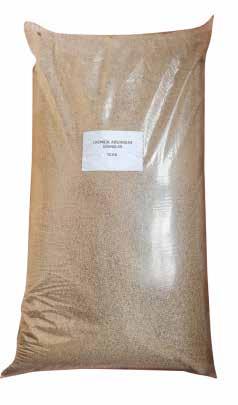
Spills spread very quickly and can cause damage to the environment, and fines and clean-up costs can be expensive. Thus, to avoid damage at the site, it is important to know where all spill kits are and how to use them. This should be coupled with an annual spill response drill to ensure knowledge of plans and how to use clean-up equipment.
• Good storage practices
To ensure proper storage, mining sites should ensure that they have a spill kit on-site and train their staff on how to use it. The site should store liquids within secondary containment, store substances away from stormwater drains and waterways, ensure storage of substances away from high-traffic areas, and make sure all storage containers are labelled. Also, it is good practice to check regularly - before and after any rain for any spillages or any flooding and ensure that the containers are not damaged or have any leaks.
• Flammable and Combustible Liquids
Generally speaking, flammable liquids will ignite (catch on fire) and burn easily at normal working temperatures. Likewise, combustible liquids can burn at temperatures that are usually above working temperatures.
Under the Workplace Hazardous Materials Information System (WHMIS), flammable liquids have a flashpoint below 37.8°C (100°F) and combustible liquids have a flashpoint at or above 37.8°C (100°F) and below 93.3°C (200°F). These may include thinners, cleaners, adhesives, paints, waxes and polishes which are present in almost every workplace.
However, sometimes more than one flashpoint is reported for a chemical since testing methods and purity of the liquid tested may vary. In some instances, flammable and combustible liquids such as gasoline, with a flashpoint of -40°C (-40°F); and phenol, with a flashpoint of 79°C (175°F) can mix their vapours and the air begins to burn.
• Flammable or Explosive Limits
The lower flammable limit or lower explosive limit (LFL or LEL) of gasoline is 1.4 per cent; the upper flammable limit or upper explosive limit (UFL or UEL) is 7.6 per cent. This makes gasoline flammable when it is in the air at levels between 1.4 and 7.6 percent. It should therefore be noted that a concentration of gasoline vapour in air below 1.4 percent is too “lean” to burn and gasoline vapour levels above 7.6 percent are too “rich” to burn. Flammable limits, like flashpoints, however, are intended as guides not as fine lines between safe and unsafe.
Most common flammable and combustible liquids have auto-ignition temperatures in the range of 300°C (572°F) to 550°C (1022°F), while some have very low auto-ignition temperatures. When solvent-evaporating ovens are heated to temperatures above the autoignition temperature of the solvents used, it results in serious fire hazards, as a flammable liquid can burn very fast and give off a lot of heat and often clouds of thick, black, toxic smoke. Also, spray mists of flammable and combustible liquids in the air may burn at any temperature if an ignition source is present.
The vapours of flammable and combustible liquids are usually invisible, which makes them difficult to detect unless special instruments are used. Most flammable and combustible liquids flow easily and a small spill can cover a large area of the workbench or floor.
Burning liquids can flow under doors, downstairs and even into neighbouring buildings, spreading fire widely. Materials like wood, cardboard and cloth can easily absorb flammable and combustible liquids; and even after a spill has been cleaned up, a dangerous amount of liquid could remain in surrounding materials or clothing, giving off hazardous vapours.
These can also cause health problems depending on the specific material and route of exposure, for instance through breathing the vapour, eye or skin contact, and swallowing. Some of these liquids are corrosive, and many undergo dangerous chemical reactions if they contact incompatible chemicals such as oxidizing materials when stored improperly.
It is therefore important to check the Material Safety Data Sheet and the supplier’s labels on the containers.
On the whole, Spill Doctor assures mining companies that it is well-resourced to meet their needs in the health, safety and environmental fields.“As a leader in internationally compliant products, we will find the unsullied product for your storage, distribution and removal of flammable liquids in a safe and legally-compliant manner,“ Murphy wraps up.
For more information, visit www. spilldoctor.co.za
14 Mining Business Africa | January - February 2023
Vac-Cent’s Vacuum pumps and compressors
Pumped up for service excellence
Vac-Cent Services, local manufacturers of vacuum pumps and compressors, is eager to serve clientele diligently as they embark on projects in 2023. While its name has become synonymous with Gardner Denver Nash Liquid Ring Vacuum Pumps and Compressors, Vac-Cent offers a broad range of product brands and solutions.
High-profile forums present an opportunity for Vac-Cent Services (Pty) Ltd to inform decision makers in the African mining sector about the relevance of its company’s pump and compressor solutions to their respective projects. And The 2023 Investing in Mining Indaba is not an exception. This is not least coming at a time when the mood in the global mining sector is bullish, illustrated by increase in projects being rolled out.
Eager to exceed expectations
As they have diligently done every year, the company’s team of competent Technical Sales Team vow that they are eager to exceed expectations in the provision of vacuum pump requirements and compressors to clientele in mining. While the market is awash with different brands of pumps and compressors, the Team believes that experience makes Vac-cent’s relevant products stand out. “In fact, what we offer is not just products, but a solution,“ states the company’s Team head declares.
Tapping into experience
As a seasoned player, Vac-cent has been on the mining equipment block for a while. It was formed in 1987. And since then, it has perfected the knack of providing appropriate liquid ring pumps, compressors and associated equipment to clientele in the mining sector. The team hopes to tap into the huge depth of experience to address the respective equipment needs of clientele in mining.
Broad range of equipment brands
Vac-cent has a broad range of equipment brands
that include vacuum pumps, compressors and channel blowers and accessories.

• Vacuum pumps



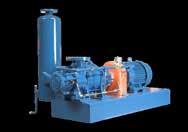
Under licence, Vac-cent manufactures the world-acclaimed Gardner Denver NASH Liquid ring vacuum pumps. In addition, the company distributes and imports Rotary & Carbon vane vacuum pumps. Vac-Cent also manufactures two different sizes of vessel-mounted filtrate pumps. These pumps are available in SG Iron and Stainless steel or a combination of the two materials. Both types of pumps are 100 per cent manufactured locally.
Enabling equipment availability
It is unfortunate that the business of mining equipment is never short of customers who get short changed by suppliers. This is a big concern to Vac-cent. However, the company recognises the importance of the availability of equipment in mining operations. That is why it offers services to ensure equipment uptime such as on-site Liquid ring vacuum pump Performance testing and Vacuum surveys.
To ensure the uptime of equipment, Vac-cent offers service exchange pumps and corrosion protection.
• Service Exchange Pumps
Vac-cent offers Service Exchange units available to help clients minimise downtime while ensuring quality repair and replacement of their pumps.
• Corrosion Protection
The company provides various coatings for new

or repaired pumps or compressors for harsh environments. The types of coatings used may include ceramic coatings, cladding, glass flake coatings or stainless steel body wear rings and head face plates. The correct protection is selected when given the circumstances in the area.
Quality Assurance
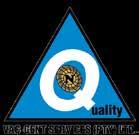
Vac-cent recognises the importance of the availability of equipment in mining operations. That is why it offers services to the subequatorial Africa and Indian Ocean islands region that ensure equipment uptime such as on-site Liquid ring vacuum pump Performance testing and Vacuum surveys.
To ensure the uptime of equipment, Vac-cent offers service exchange pumps and corrosion protection.
The Head of the Technical sales team at Vac-cent affirms that Vac-cent adheres to the highest quality standards in the provision of solutions to the clientele. Its commitment has been recognised by the ISO 9001:2010 seal of approval for quality, an accreditation it has held since 1994.
Opportunities in mining projects
Vac-cent’s is eyeing opportunities to participate in African mining projects in 2023 and beyond. The Team Head says that its competent Technical Sales Team are on hand to handle any needs of clientele of any scale in the areas relating to installations and improvements to current processes.“We are pumped up for service excellence.“
Repair & Service
Technical Sales & Support

Service

Mining Business Africa | January - February 2023 15
FEATURE N A S H L I Q U I D R I N G V A C U U M P U M P S V a c - C e n t S e r v i c e s h a s b e e n m a n u f a c t u r i n g
A S H L
u i d R
c
P u
p s a n d
N
i q
i n g V a
u u m
m
C o m p r e s s o r s 1 0 0 % L o c a l l y s i n c e 1 9 8 7
A
V a c - C e n t S e r v i c e s o f f e r t h e e n t i r e N
S H
a n g e W e m a k e i t t o s u i t y o u r p r o c e s s ! V A C - C E N T S E R V I C E S ( P T Y ) L T D O F F E R S T H E F O L L O W I N G : New
Vacuum
V a c u u m P u m p a n d C o m p r e s s o r r
Engineered
Pump Sets
H E A D O F F I C E 1 2 4 S N A P P E R R O A D W A D E V I L L E T : + 2 7 1 1 8 2 7 1 5 3 6 I N F O @ V A C C E N T . C O . Z A W W W . V A C C E N T . C O . Z A
Exchange Vacuum Pumps On Site Performance Testing
Ground support for deep-level mining operations
A practical alternative to resin grouted rockbolting
Ground support systems have been used for over a century in mines across the world. The use of rockbolts has been documented as early as the late 19th century, where reinforced steel was used to stabilise rock walls in mines.
The technology has evolved, as mine operations tunnel deeper, requiring new support for different ground conditions. In such environments, effective ground support equipment is required to reinforce the rock around excavated tunnels, to facilitate safer and more efficient operations, and successful installation is critical to ensuring the capacity of the rock reinforcement element.
The traditional installation of resin grouted rockbolts requires a support hole to be pre-drilled followed by the installation of the resin capsule. The rockbolt is then spun into the grout, mixing the resin completely.
Challenges when installing resin capsule grouted rockbolt
Epiroc Ground Support has extensive experience
with testing the integrity of resin grouting solutions in varied environments. The research has noted the typical challenges facing miners installing resin capsule grouted rockbolts as follows:
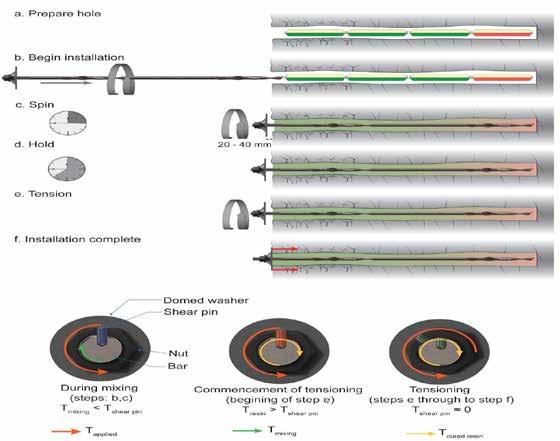
• Ensuring a quality installation, the diameter of the support hole, the rate of rotation, rate of insertion and spin time must be monitored to ensure an effective installation. Mistakes can prove costly, as any deviation from the manufacturers specifications may result in a reduction of resin strength, and failure of the support system.
• In highly stressed, poor ground conditions, the presence of fractures, shear features and altered rock can lead to unravelling of the support hole, resulting in blockages preventing the installation of the resin capsules. Efficiency is then affected, as support holes may need to be re-drilled, leading to oversized holes, increased installation times and poor installation quality.
• Lastly, the resin within the capsules is fixed, therefore variations in hole diameter and
resin losses into voids may cause a failure to achieve a full column bond.
The solution
Having observed the challenges that impact the integrity of the rock reinforcement system when using resin capsule grouted rockbolts, the experts at Weber Mining and Tunnelling and Epiroc partnered up to develop a high strength polyurea silicate resin, Potentia® Thixo. Potentia® Thixo, in combination with the high performance Boltec and post-grouted rockbolts developed by Epiroc, offers an effective solution to overcome the challenges faced with capsule resin installation.
Achieve full column
This installation process is more resilient to changes in the rock mass. When the rockbolt is inserted into the predrilled bore hole and the pumpable resin is then injected through the rockbolt filling the bore hole from the back to the collar. Post grouting ensures that a full column is achieved as resin is injected through the bolt until
16 Mining Business Africa | January - February 2023 FEATURE
resin is observed at the perimeter of the plate. The thixotropic nature of the resin ensures the resin remains in the borehole whilst rapidly curing to strengths in excess of 35 MPa.
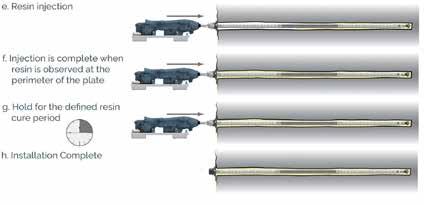
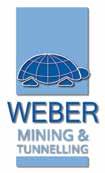
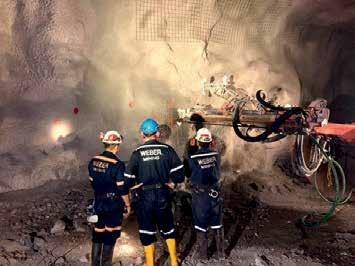
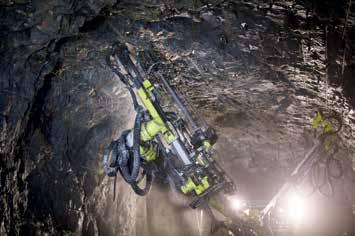
Easy to transpor t
Additionally, the resin and catalyst, which are the two components of Potentia® Thixo resin are stored and transported in IBC.

Shelf life
The 2-year shelf life is not affected by changes in temperature, which simplify logistics and supply chain.
Quality
The quality of the mixed Potentia® Thixo is auditable and assured as the two components are mixed in a 1:1 ratio by a digitally controlled pumping system on the Boltec. This ensures the quality of the resin mixture is established prior to injection into the rockbolt and remains consistent through varying ground conditions. With a setting time that can be tailored from 35 seconds for bolting applications to 900 seconds for cable bolting applications.
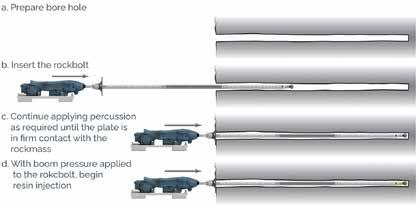
Mining Business Africa | January - February 2023 17
Continuous Vibrating Equipment Condition Monitoring Up-to-the-minute Equipment Condition Monitoring
“Vibrasure”, offered by Vibramech, enables effective real-time monitoring & predictive maintenance of vibrating mineral processing equipment, ensuring dependability through this critical phase of production. By utilising Vibrasure’s online continuous condition monitoring system, one can ensure that the vibrating equipment performs at its optimal best, consistently & reliably.
Healthy vibrating equipment forms part of the lifeblood of the mineral processing industry worldwide. That is why Vibramech understands that no one in this industry tolerates unexpected failures of equipment, especially when one is pulling out all the stops in increasing production. And when a failure does occur, the loss of productivity and the attendant loss of revenue, or irreparable damage to equipment, or at worst causing injuries, are totally unacceptable. So, how can this be minimised or preferably avoided?
Vibrasure
In recognising the critical importance of ensuring the productivity (uptime) of vibrating equipment, Vibramech introduced Vibrasure in 2021.
David Massey, Vibramech’s MD, is thrilled to offer this solution: “Vibrasure was introduced to enable mining companies to effectively manage and maintain the health of their vibrating equipment, resulting in maximum uptime. We all know what a crucial role vibrating equipment plays within a mineral processing plant. Therefore, Vibrasure essentially allows
for early fault detection, diagnosis and analysis, and for the formulation of a solution prior to a serious breakdown. Also, Vibrasure perfectly complements Vibramech’s extensive footprint of industry-acclaimed vibrating equipment.”
Online condition monitoring
Vibrasure is an online condition monitoring system that enables real-time continuous vibration monitoring of, and feedback on, the equipment’s operational performance parameters at any given time, such as vibrating frequency, stroke, angle of motion and
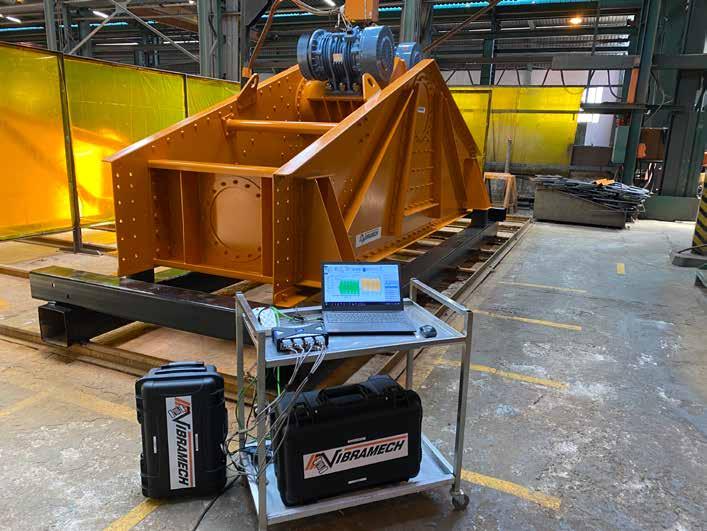
18 Mining Business Africa | January - February 2023
FEATURE
Vibrasure’s online condition monitoring system in use
temperatures, and it will detect and provide early warnings against machine faults.
Why Vibrasure?
Vibrasure is recommended by Vibramech, an expert with over 45 years experience in the design, manufacture and maintenance of vibrating equipment.
Vibramech is Southern Africa’s leading Original Equipment Manufacturer of a wide range of vibrating mineral processing equipment, with over 10 000 pieces of equipment currently in operation, worldwide. In scrutinising the needs and developments in mineral processing with a vested interest, Vibramech is eager to impart its extensive know-how in the maintenance of its vibrating equipment to all of its clients, and the best way of doing so is with the implementation of Vibrasure.
Although there is a variety of online vibrating equipment monitoring products available in the open market, David Massey emphasises that Vibrasure’s platform and functionality are derived from the company’s specialist expertise in the supply and maintenance of vibrating equipment.
In this regard, Vibrasure through predictive maintenance will put mining companies in a wellplaced position to cope with, and even mitigate the risk of breakdowns. The use of structural and bearing sensors that are designed with the latest technology, and which are IP69K rated to withstand the harshest of conditions, coupled with long-life integral batteries, ensures that the end user receives all of the valuable information needed to maintain effective production.
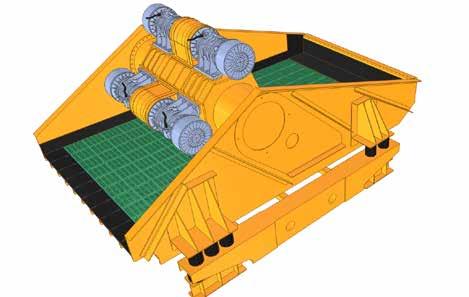
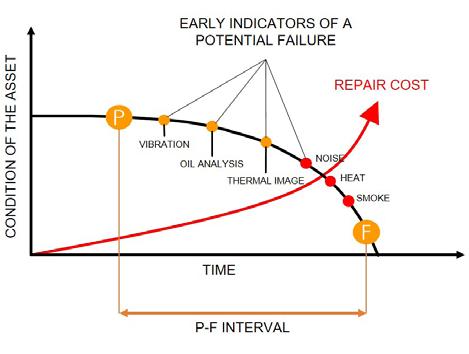
The system, in particular, reports key parameters to a cloud-based platform, where the data can be trended over time to optimize the performance of vibrating equipment. “We offer as an added option, that the data from the cloud-based platform could alert our engineers of serious deviations in equipment performance, giving our clients the additional comfort of knowing that they will be forewarned of possible breakdowns.”, Massey outlines.
High-quality assurance standards
Underlying the creation process of Vibrasure, was Vibramech’s own high-quality design and manufacturing standards in the provision of its equipment. It is worth highlighting that the company’s quality control & assurance programmes make provision for, inter alia, full 3D vibration analysis to be conducted on all equipment prior to release. “Our design practice makes use of finite element analysis and strain gauge analysis to prove structural integrity, with detailed attention paid to wear protection and commonality of components to maximise productivity and minimise spare part inventories.”, says Massey, adding that this enables Vibramech to set a benchmark for the life of the equipment, that exceeds the industry standards.
As with all of the equipment that Vibramech offers, its Vibrasure product is equally robust and has a long life expectancy. Overall, the
introduction of Vibrasure has received a hugely positive response from the industry, and this underscores Vibramech’s commitment to providing quality, reliable, and robust vibrating equipment.
Through Vibrasure, Vibramech offers an additional safety net enabling its clients to depend on its equipment, by advancing reliability & endurance over the long term.
Market leader in vibrating mineral processing equipment
Vibramech supplies its equipment primarily to mining and mineral processing industries across the globe. Particularly, it has extensive experience in gold, diamond, coal, iron ore, manganese, platinum, chrome, nickel, uranium, copper, mineral sands and aggregate minerals.
Since its establishment, Vibramech has installed 10,000 pieces of equipment in mines worldwide, but predominantly in South Africa. This has positioned the company as a market leader in the supply of vibrating mineral processing equipment to both project houses and mines in South Africa and the region. “We believe our reputation is richly deserved. It is a consequence of continuous technological innovation over four decades and this has cemented our status as an OEM of dependable equipment, which stands out for its robustness and reliability throughout the world.”
Visit Vibramech’s website at www.vibramechglobal.com for an overview of how Vibramech could assist with your current and future mineral processing requirements.
Mining Business Africa | January - February 2023 19
Turnkey snake awareness for exploration & mining projects
Containing the risk of snake bites and attacks
Wherever there are mining activities, snakes pose a huge threat to the safety of employees. So far, improved awareness is the most potent weapon in mitigating the risk they pose. However, African Reptiles & Venom recommends that only a credible service provider must be engaged to conduct snake awareness courses among employees at all times.
called ‘low-hanging fruits. In a nutshell, as far as health and safety issues go, it is better to err on the side of caution with snake encounters or bites.
This is the viewpoint of Mike Perry, the Managing Company Owner of African Reptiles & Venom. As an old hand in snake awareness, he is tirelessly advocating for an attitude change towards containing risks from snakes mineworkers face. African Reptiles & Venom is a highly esteemed provider of relevant turnkey snake awareness solutions to companies in the mining and other sectors.
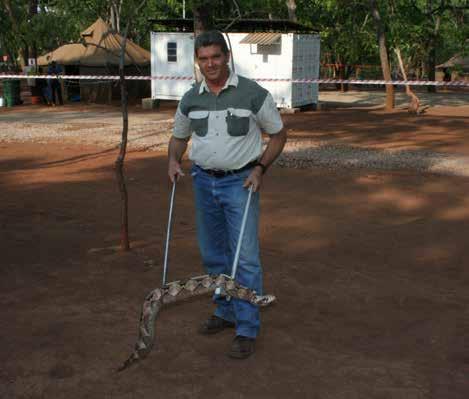
Raising awareness
Based on the company’s extensive know-how, Perry is keen to raise awareness about the risk mining companies face, highlighting the level of prevalence at mineral exploration and mine development and operation phases. This is above and beyond the relevance of the company’s turnkey snake awareness solutions. Prevalence
of snakes
Usually, there is a high prevalence of snakes both at mineral exploration and mine development and operation phases.

• Mineral exploration phase
Legislation – the Mine Health and Safety (MHSA) and Occupational Health and Safety Act (OHSA) - obligates mining companies to leave no stone unturned in the quest to achieve compliance. Unfortunately, the reality is that some mining companies tend to be selective - unwittingly or not - in containing identified safety risks.
The overlooked safety risk
Conspicuously, the primary focus is on so-called ‘low-hanging fruits‘ like fire accidents and fallat-height, just to cite a few. And in the course of this, inherent risks from snake encounters or bites that equally merit similar attention are ignored or underestimated.
Actually, wherever mining companies have operations, the risk of snake encounters or bites should be regarded as high at all times. It is rational to approach the risk of snake encounters or bites in a similar manner they do with so-
The location of the mine during the exploration phase determines the level of prevalenceWhether or not it is close to green fields during the exploration period by drilling companies and the number of people involved in the drilling. Typically, while the drilling takes place the snake population will remain intact, and will not be disturbed by this process.
• Mine development and operation
Once minerals have been discovered and planning has been completed, the steps that follow are: clearing the bush, and erecting buildings and infrastructure like the plant, mine shafts, clinics and hospitals, living quarters and dining areas. Due to these activities, there are a lot of encounters with snakes - depending on where the mine is situated.
After completion, as soon as there is an influx of people onto a mining site, there are large quantities of waste food disposed of, which will attract rodents by the thousands. This in
20 Mining Business Africa | January - February 2023
FEATURE
African Reptiles & Venom has a hands-on approach to snake awareness.
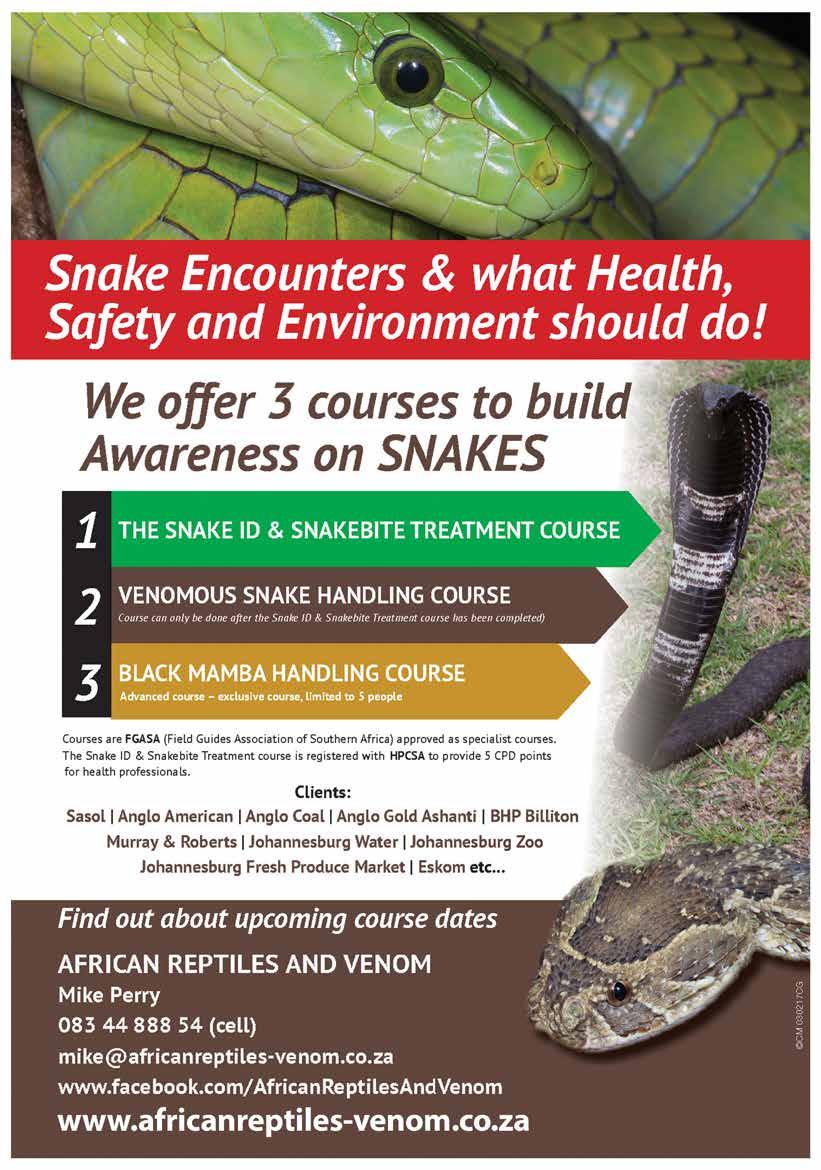
turn will attract an influx of snakes. Usually, the following areas in operating mines are prone to high snake presence (risks) - living quarters, dining areas, storage facilities or any areas that border virgin bush next to falling dams.
On a different note, seasons also need to be taken into consideration as a factor in the prevalence of snake populations - hot, dry, cold, or wet. These will influence activity.
Turnkey snake awareness
There may be several techniques – if any - to manage the risk of the presence of snakes in mining environments. Arguably, while others may work, if at all, African Reptiles & Venom has identified raising employee awareness as the most effective way to manage the risks. And so, it has devised mining-specific turnkey snake awareness solutions segmented into the following areas: Snake identification, First Aid for snakebites, Snake bite treatment and Handling technique.
While the company’s snake awareness solutions are segmented, Perry stresses that they can be customised to suit the needs of clientele. This is because every mine may have unique risks they face from potential snake attacks. For this reason, the company ensures that a mine is provided with a solution suitable to its challenge, as Perry demonstrates: “Upon reaching the mine, we will do a walk around assessment, advise Health and Safety officials of existing and potential risks, and make recommendations that are appropriate to the mine.“
The service providers‘ competence
In no doubt, African Reptiles & Venom bends over backwards in its commitment to delivering relevant solutions to client expectations. That is why the company is concerned about how mining companies approach procurement of snake awareness – a critical area in mine health and safety.
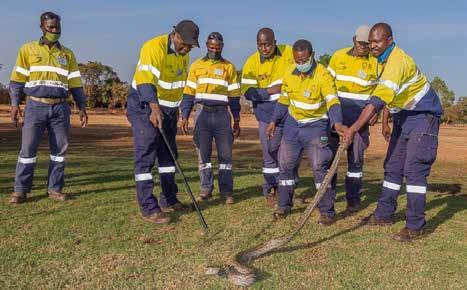
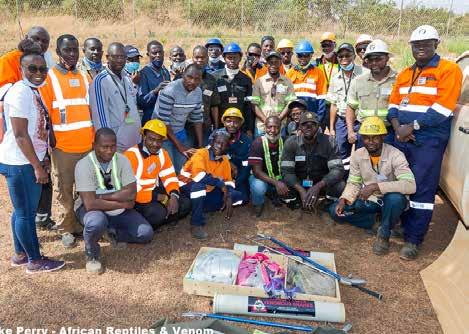
Perry tells mining companies to separate the wheat from the chaff among companies claiming to provide snake awareness solutions. “There should be no cutting corners in the mitigation of risks from snakes, as shortcuts can put the lives of employees at risk.“
By and large, he advises mining companies to consider the following when looking for a competent service provider:
• The company should have a credible history and involvement with snakes;
• The organisation should be under someone in the company who is accredited as an expert in the field;
• It is important to get a summary of the layout of the course to see the quality; and
• Do not use price as the sole determinant of procurement decisions. Nine times out of ten the cheap price is a red flag. The rule of thumb is: The cheaper the course, the lower the quality and the higher the risks of incidents.
African Reptiles & Venom’s credibility
Currently, mining companies are embarking on greenfield and brownfield projects in areas where there is likely to be a huge prevalence of snakes. So, Perry warrants there should be no question about the African Reptiles & Venom’s credibility. Noticing increasing potential risk to employees from snake attacks and bites, he says the company is keen to leave no stone unturned in imparting its know-how in snake awareness.
The scope of African Reptiles & Venom’s turnkey snake awareness course
The course starts with a theoretical session with content which consists of the below. A PowerPoint presentation is done by Mike Perry with images explaining all the necessary information, covering:
1. Snake Awareness
2. How to identify snakes
3. Dangerous snakes found in their specific regions
4. Prevention of snakebite
5. Snakebite syndromes
6. First Aid for snakebite treatment
7. Medical snakebite treatment
8. Recognition and treatment of allergic reactions
Introduction to safe snake handling
• Rules to apply for snake handling without causing medical emergencies
• Safe snake handling equipment, First Aid for snakebite kits and how to use it.
• How to catch different snakes illustrated using slides and video.
22 Mining Business Africa | January - February 2023
FEATURE
Only a credible service provider must be engaged to conduct snake awareness courses
Environmental Impairment Liability (EIL) Insurance for mining operations
Insuring against third-party environmental impairment liabilities
Are mining companies well-equipped to handle third-party environmental impairment liabilities? James Brice, Head of Environmental at iTOO Special Risks, outlines to Mining Brief Africa critical steps mining companies must take.
South African legislation requires that all local mining operations must ensure they make financial provisions to guarantee the availability of sufficient funds to undertake rehabilitation and remediation of the adverse environmental impacts of mining activities, not only during the life of the mine, but also at closure.
“Current regulations around mine rehabilitation and closure guarantees mean that mines are obligated to close their operations responsibly so that they can return the land to its prior use,” explains James Brice, Head of Environmental at iTOO Special Risks.
“This is based on the theory behind mining, which states that while you can take what you want from underground, you must return the land to the landowner who can resume activities on it as before the valuable component was extracted.”
Typically, mining rehabilitation regulations focus on first-party obligations, such as when a mine has a pit, tailings dam or discard dump, which is operated and owned by the mine on its premises and that causes some change to the land.
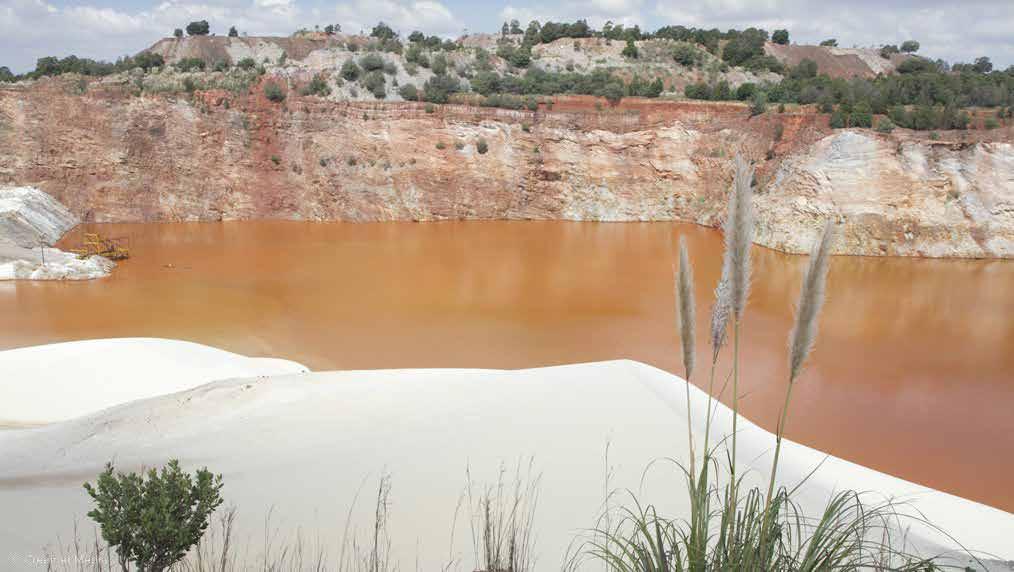
“Mines are generally good at following regulations. They will often bring in a consultant
to quantify these obligations and then they follow the regulations around having a financial guarantee to cater for planned or unplanned closures,” says Brice.
“This means that even if the commodity price drops and a mine goes bankrupt, at least they have this reserve financial provision parked away to be able to do good by the environment and return the land to the landowner. This is called a financial guarantee.”
Focus on first-party liabilities
He explains that while insurance companies provide financial guarantees to mining
Mining Business Africa | January - February 2023 23
FEATURE
Acid mining drainage as a result of mining
operations, these typically cover first-party liabilities and the cost of doing good for the environment. Usually, these are risks are wellknown and quantified.
“The problem is that often mining operations forget to worry about third-party liabilities, such as those stemming from neighbours, communities and downstream water users who may have been affected by the mine,” says Brice.
“And because there’s been a focus on firstparty rehabilitation, there has been little in the way of allocating financial provisions to cater for affected third parties, with about 95% of South African mines not having any financial provisions or insurance coverage for these financial liabilities.”
All too often, mining companies tend to extend their mining rehabilitation guarantees to cover things like dust affecting the surrounding community, which can increase the risk of cancer risks, or acid mine drainage that can sterilise downstream wetlands, rivers and dams.
“We have seen some high-profile mining incidents lately, such as acid mine drainage spills at Tugela in March and Zululand Anthracite Collieries a year ago and the tailings dam collapse at Jagersfontein in September. None of those companies were insured against this type of risk,” says Brice.
In this event, he explains, companies are forced to take a hit on their balance sheets,


which in turn impacts their shareholders, so many are reluctant to pay out. Yet, mines must do the right thing.
“The solution lies in having the right insurance product for the right type of risk. The problem with extending financial guarantees is that there are certain regulations around what this money can be used for.
“It has to be liquid, so in most cases, this money cannot be invested in long-term projects and will at best earn money market returns of 7-9%. Normally, a Chief Financial Officer would be looking for a 25-30% return on equity.”
Brice says that instead of investing anywhere between R20 million and R150 million into their financial guarantees to cater for something that may not happen, it would be much more efficient for mining companies to take up an insurance product that does not have to be self-funded.
Transferring third-party risk
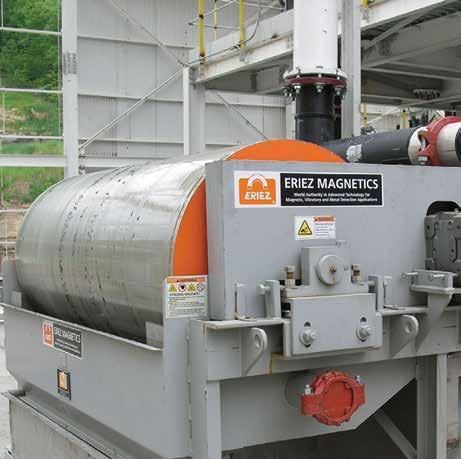
“With a product like iTOO’s MineSafe, mines pay a premium and transfer their third-party risks to our balance sheet. The premium payable is similar to that for a financial guarantee, but companies do not have to self-capitalise. They can use this money for operational growth and expansion instead.”
Brice says that it is also important for mining companies to keep in mind that especially with dust or water pollution, the contaminants would have spread over many years, if not decades,
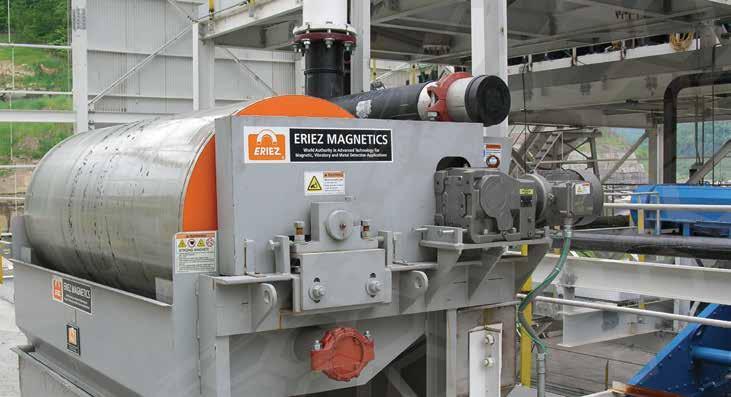
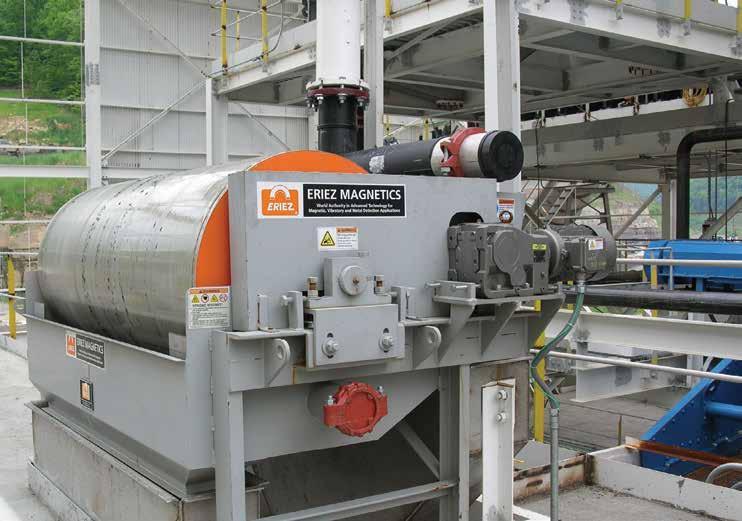
potentially affecting many more potential claimants, leaving mines exposed to a class action.
Mines are in a precarious position and iTOO is the only insurer that can place cover for gradual pollution liability, including historic and existing pollution. This is a comprehensive policy that covers seven insuring clauses for peril: emergency response; legal defence; third-party bodily injury; third-party business interruption; ecological restoration; clean-up; and ongoing monitoring and reporting to a public liaison.
Brice notes that when choosing suitable environment impairment liability insurance, mining companies should determine whether the insurer has the technical ability to give them credit for the environmental rehabilitation work that has already been done.
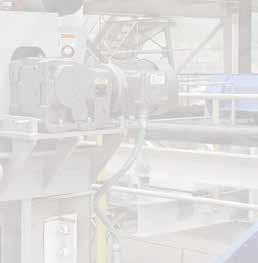
“We believe in rewarding clients for doing the right thing in terms of what is good for the planet. As iTOO, we expend a lot of money at our own costs and risks to do risk assessments, interview management and study the monitoring data,” says Brice.
“This is a lengthy process, but it is important to fully understand the risk and be sure that we design a product that fits the actual requirements and to also give the client credit for what they are doing correctly.”
24 Mining Business Africa | January - February 2023
FEATURE Optimize Your Roughing, Cleaning & Scavenging with Eriez Magnetic Elements & Tanks • Hybrid Rare Earth-Ceramic elements produce greater recovery in cobbing and roughing stages • Cleaning and finishing magnetic elements improve selective separation Eriez.com | 814.835.6000 Greater Recovery Better Grade with Eriez Deep Field 3,500 Gauss Magnetic Wet Drums Eriez_WetDrum_HalfPg_MMAfrica9_22.qxp_Layout 1 9/29/22 3:02 PM Page 1
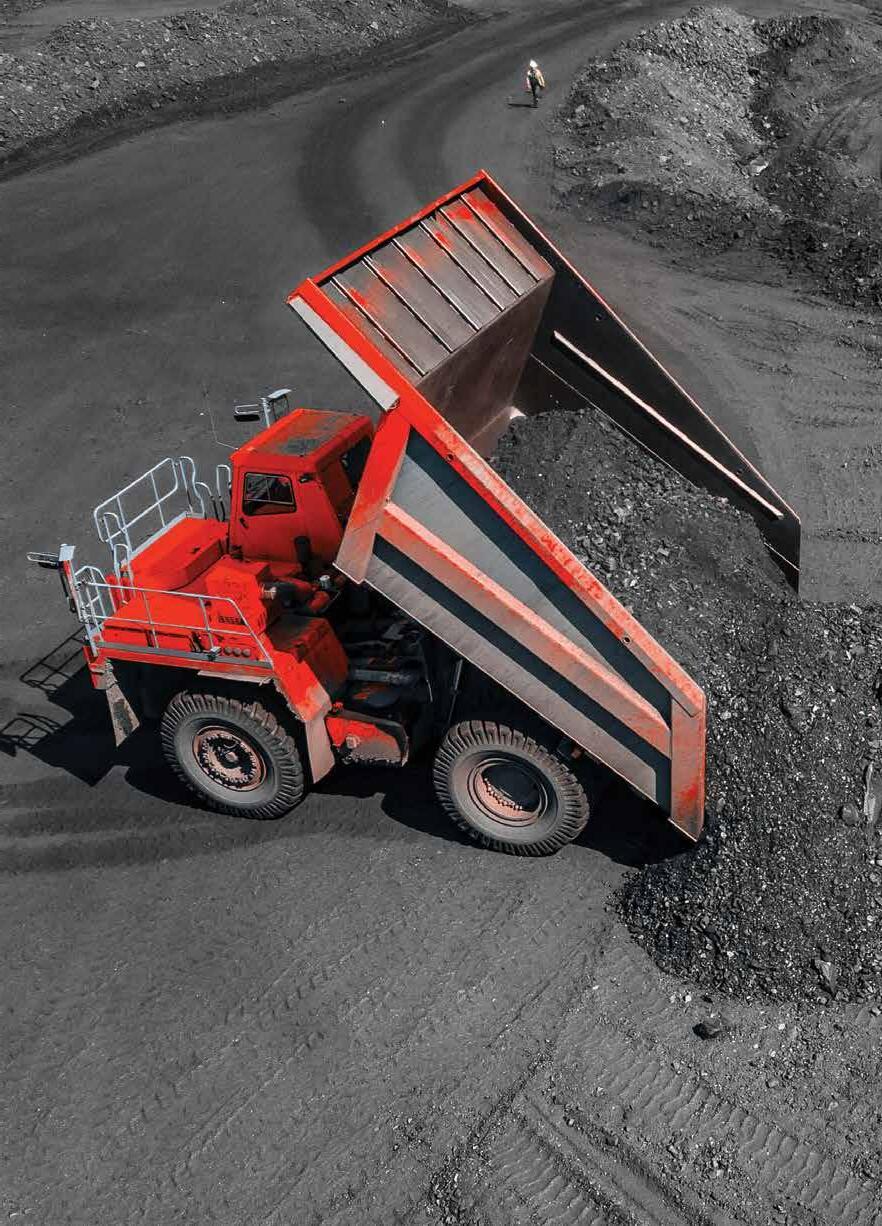
Optimise your mine’s balance sheet exposure with iTOO’s MineSafe product - the only cover that ensures you’re covered for both historic and existing mining liabilities. Speak to your broker to get cover or visit www.itoo.co.za iTOO Special Risks (Pty) Ltd (Reg. No: 2016/281463/07) is an authorised Financial Services Provider (FSP No. 47230) underwritten by the Hollard Insurance Company Limited (Reg. No: 1952/003004/06), a licensed non-life insurer and an authorised Financial Services Provider. Think Expert. Think iTOO
FEATURE
A new perspective on modern-day maintenance
By Raymond T. Chizu, Business Developer, WearCheck Zimbabwe

LearCheck provides thousands of customers each year with world-class condition monitoring (CM) services, which have been proven time and again to save time and money for companies by identifying potential machine failure before it happens and remedying the problem.
However, in our line of work as condition monitoring (CM) specialists, we still do come across customers who have everything to gain by using the CM techniques we offer but, unfortunately, they don’t see the benefits to be gained. No matter how hard we try to convince them, they stubbornly continue to refuse help.
In this article, I’m going to try to get to the bottom of this standoff and hopefully we’ll find ways to engage every maintenance organisation to employ condition monitoring techniques whenever it is economically practical to do so.
I’m going to start with the definition of maintenance and then go through the changes to which maintenance has been subjected over the years. This knowledge, I believe, will help us understand some conflicting behavioural patterns exhibited by some maintenance personnel.
The verb ‘maintain’ gives the idea of preserving/keeping a certain status or specification. In engineering terms, maintenance is the execution of those tasks that ensure that the asset/plant owner achieves design and performance specifications of their asset/plant in order to meet their business objectives.
Let’s take a look at the internal combustion engine as an example. For the engine to operate at optimum level, the lubrication system must be at a certain pressure and temperature, the cooling system at a certain temperature, and the fuel system and the compression should be at a certain pressure. In this case, maintenance activities will include regular testing, adjusting, lubricating and cleaning.
The focus of maintenance should be upon the ‘wellbeing’ of the plant/asset – when the task is to ‘fix it’, then maintenance has failed its basic mission, quite possibly through no fault of its own. With the definition out of the way, let’s look at how maintenance has changed during the course of time. Modern maintenance has gone through three generations:
First generation
Its inception is traced back to the beginning of
the industrial revolution right up to about the First World War. Maintenance then was premised on the ‘Fix It When It Broke’ philosophy, better known as Breakdown Maintenance (BdM). This was ideal at that time because machinery was quite rugged, overdesigned, relatively slow running, and the instrumentation and control systems were very basic. Production demands where not overly severe and downtime wasn’t usually a critical issue. Most of the labour was manual. Even up to this day there are still some machines in existence that were manufactured around that time, which are still running as good
as the day they were made.
Second generation
From the Second World War to the end of 1950s - with the rebuilding of industry after the war, a more competitive marketplace emerged, and along with this, an increasing intolerance of downtime. The cost of labour increased significantly, and this led to more and more mechanisation and automation. Machinery was of lighter construction and ran at higher speeds. These machines wore out more rapidly and were seen as less reliable (perhaps it was because they were being utilised more fully).
Production demanded better maintenance, which led to the development of Planned Preventive Maintenance (PPM). The philosophy behind this maintenance concept was that machinery should be overhauled on a regular basis regardless of whether repairs were needed. For example, in 100 pieces of identical equipment, a failure rate of 10 units within a similar period renders the probability of failure as unacceptable and the full group of machines should be overhauled (despite the significant losses in potential life in the other 90 machines). The belief was that every item has ‘the right time for overhaul’, which could be discovered and must never be exceeded.
The planning involved plant overhauls based on a time or usage interval (at which the failure rate was deemed unacceptable). Since mechanical parts always wore out, this led to the basic assumption that ‘the older the machine gets, the more likely it is to fail’ and that equipment is better protected from failure by

26 Mining Business Africa | January - February 2023
Raymond T. Chizu, Business Developer, WearCheck Zimbabwe
‘frequently overhauling’.
This is the period in which Swedish engineer/ scientist/mathematician Waloddi Weibul developed the Weibul distribution density matrix in 1951, which is popularly known as the Bathtub Curve in the maintenance field, and which was believed to be applicable to all machines.
Nowlan and Heap categorised failures into three classes:
i. Infant mortality/early life/burn-in,
ii. Random/useful life and
iii. Wear-out/end of life failures.
Third generation
In the 1960s, with the introduction of the Boeing 747, the aviation industry - in its search for improved reliability - questioned the then trending maintenance philosophy with the basic assumption that the older the equipment gets, the more likely it is to fail.
At that time, aviation accidents were in the order of 60 per million take-offs. For an aircraft to achieve 20,000 flying hours it required some 2,000,000 man-hours of maintenance performed on a time- or hours-run basis. This basic assumption was questioned, and the failure process was extensively researched. This research, titled Reliability Centred Maintenance (RCM), was conducted by engineers Stanley Nowlan and Howard Heap for United Airlines in 1978. The research yielded six failure patterns, and out of these, only three patterns showed a relationship to increased probability of failure with age, and they totalled only 11% of failures.
The remaining 89% of failures showed no relationship to the equipment’s age. The conclusion was: failure is a random event though it has the potential to give warning of its development through changing levels of suitable measurement parameters. This study marked the birth of Reliability-based, Condition-based and Predictive Maintenance (PdM) concepts. To look out for and find these signals is the only way to identify a need for maintenance under conditions of a constant probability of failure.
As a result of this study, the aviation industry made major changes to its maintenance practices and the results were dramatic. For an aircraft to achieve 20,000 flying hours now requires 66,000 man-hours of maintenance (down from 2,000.000 hrs) representing a 3030% reduction in man-hours of maintenance.
The reduction in maintenance hours dramatically improved safety and reliability in the aviation industry (and highlighted the fact that unnecessary maintenance can be intrusive), though some of the improvements can be attributed to improved designs and technology advancements.
Engineers Nowlan and Heap’s study culminated in the invention of the P-F (Potential Failure) Curve, whose main function is to illustrate how equipment fails and how early detection of a potential failure provides time
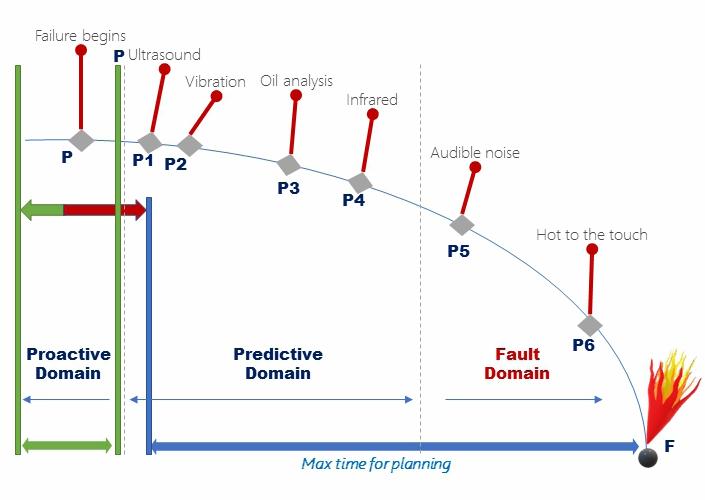
to plan and schedule the replacement or restoration of a failing part without interruption to production.
Initially, reliability-centred maintenance (RCM) was tailor-made for the aircraft industry, and the legendary Zimbabwean/British maintenance specialist, John Moubray converted it into a universally-usable technique applicable to the maintenance of any physical asset, naming his work Reliability-centred Maintenance II (RCM2) in 1991.
Further studies in maintenance are being carried out. Of interest is the Du Pont Chemical Company study carried out by Winston Ledet in 1994, which he christened The Manufacturing

Game. He came out with several interesting observations:
1. Industrial plants with a reactive maintenance culture were found to have, on average, an uptime of 83.5%.
2. When these industrial plants implemented only planning, their uptime improved on average by 0.5% (from 83.5% to 84%).
3. When these plants implemented scheduling only, their uptime improved by 0.8% (83.5% to 84.3%).
4. When these plants implemented preventive/predictive maintenance only, their uptime decreased on average by -2.4% (83.5% to 81.1%). This is due to
Mining Business Africa | January - February 2023 27
Winston Ledet 1994 Du Pont study.
additional downtime to conduct preventive maintenance work.
5. When these industrial plants implemented all three tactics of planning, scheduling and preventive/predictive maintenance, their uptime increased on average by 5.1% (83.5% to 88.6%).
6. When these industrial plants practiced planning, scheduling, had a preventive/ predictive maintenance programme and implemented Defect Elimination, their uptime increased by a whopping 14.8% (83.5% to 98.3%).
This is what is shown in the Winston Ledet 1994 Du Pont chart.



















Conclusion


We’ve had an in-depth analysis on the subject of maintenance, and I believe we can now tackle the issue raised at the beginning: “why do some maintenance plants fail to embrace condition monitoring?”
In their 1978 United Airlines RCM report, Nowlan and Heap addressed a similar question: Why do most maintenance organisations manage equipment reliability with time-based preventive maintenance (PM) programmes?
And this is what they had to say: “The chief focus has been on anticipating the age at which equipment was likely to fail, rather than on how it fails and the consequences of such failures. As a result, there has been insufficient attention to the failure process itself, and even less attention to the question of ‘precisely what constitutes a failure’?”
That mentality hasn’t changed much some 50 years later. So, what it means is that the default maintenance concept is timed-based preventive maintenance and reactive/breakdown maintenance spiced with some elements of RCM, CBM, predictive and proactive concepts. Though there are organisations that are successfully implementing RCM, at the same time there are many more who are not at all successful at it. The sad part is that there are numerous studies that have been carried out by renowned maintenance gurus on the subject over the past 50 years or so, which are now ‘gathering dust’ on the internet. Could it be that most maintenance personnel do not understand the RCM studies, hence they aren’t utilising them?
My answer to the question posed right at the start of this article – why do some organisations


not embrace a good condition monitoring programme? - is that maintenance organisations that do not seek out CBM/predictive maintenance services are stuck in the 1st and 2nd maintenance generations.












Personally, I don’t believe failure to do CBM has everything to do with setup, it’s more to do with the maintenance culture of the organisation in question. Though one could succeed to set up CBM in a breakdown maintenance environment (this could be mainly due to strong willpower and perseverance from certain individuals), the question of sustainability arises. Will this continue after the leading individuals are no longer occupying their current posts?
Mining Indaba 2023



WearCheck looks forward to welcoming visitors to its stand (D16) at Mining Indaba from 6 – 9 February 2023 in Cape Town.










For more information, please visit www.wearcheck.co.za, or email support@wearcheck.co.za or call WearCheck head office in South Africa on +27 (31) 700-5460.
WearCheck, Africa's leading condition monitoring company, is committed to serving the mining industry with its range of sophisticated analytical techniques.



Our specialist oil, coolant and fuel testing programmes allow customers to reduce maintenance costs, avoid unexpected mechanical failures and ultimately reduce unscheduled downtime.
Unlock Machine Reliability!

28 Mining Business Africa | January - February 2023
Branches Botswana DRC Ghana Mozambique Namibia Uganda Zambia Zimbabwe +267 311 6829 +260 977 622 287 +233 54 431 6512 +258 85 792 7933 +264 81 141 7205 +256 78 529 6994 +260 212 210 161 +263 24 244 6369 + 27 31 700 5460 support@wearcheck.co.za www.wearcheck.co.za South Africa (Head Office)
production Testing and Analysis | Lubricant-Enabled Reliability | Asset Reliability Care C M Y CM MY CY CMY K WCK Mining Business Africa 180x130 (PRINT).pdf 1 2023/01/13 8:17 PM
Condition monitoring is KEY to mining
FEATURE
AFRICA’S LARGEST ENERGY, OIL & GAS CONFERENCE AND EXHIBITION




JOIN THE 2023 PROGRAMME
100+ 300+
INDUSTRY EXPERTS
PARTICIPATING COMPANIES
HARNESSING A SUSTAINABLE AFRICAN ENERGY INDUSTRY THROUGH PARTNERSHIPS
• AFRICAN CONTENT SERIES
• DIVERSITY, EQUALITY AND INCLUSION
• SAIPEC PROSPECTING
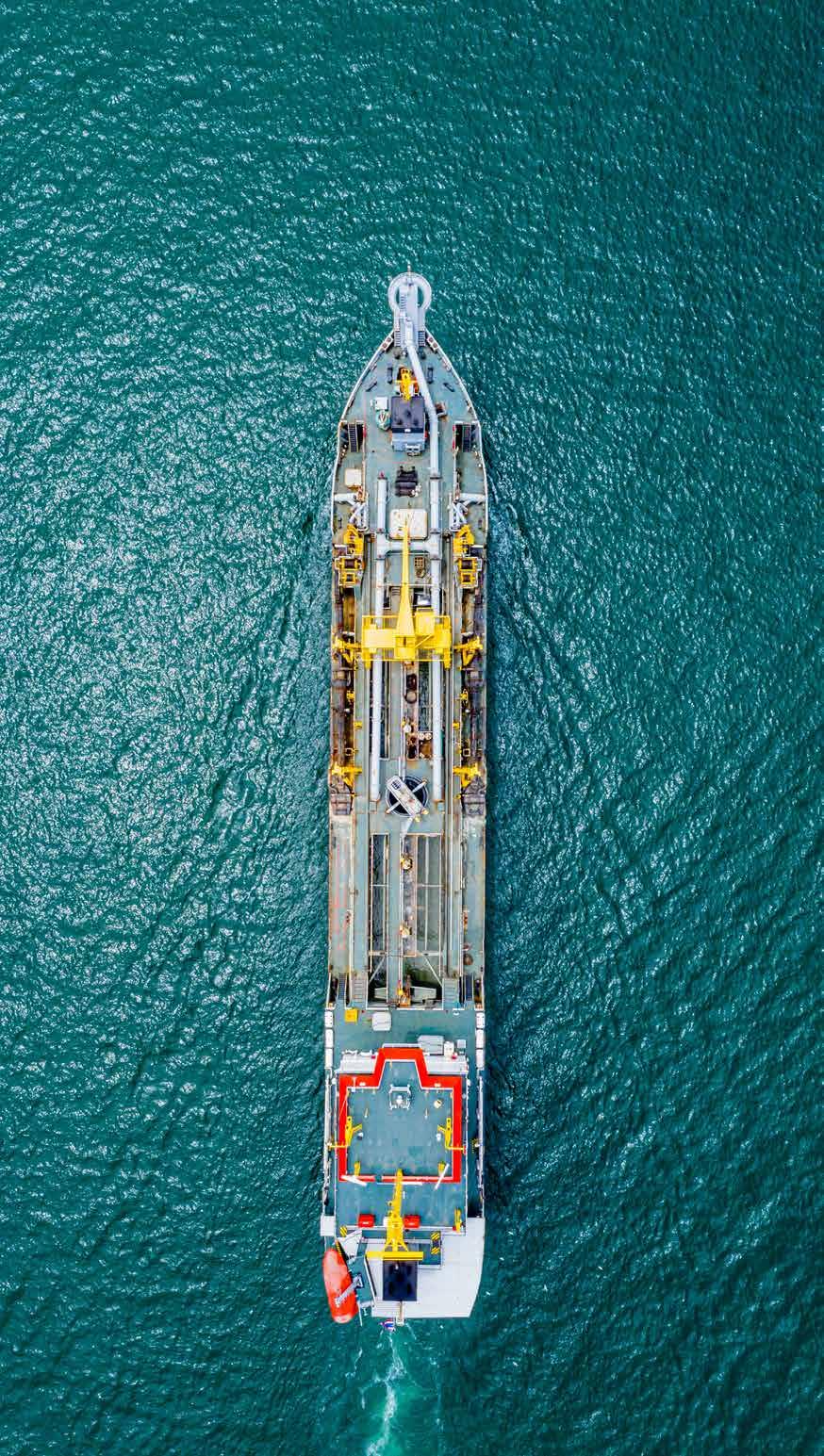
• THE SAIPEC AWARDS
SCAN THE CODE TO REGISTER
#SAIPEC2023
• SAIPEC TECHNICAL PROGRAMME

• BUSINESS MATCHING
• PETAN GOLF DAY
SCAN THE CODE TO VIEW THE PROGRAMME

REGISTER NOW AT SAIPEC-EVENT.COM/REGISTER
SPECIAL EARLY RATE ENDING SOON
SPECIAL RATES AVAILABLE TO PETAN MEMBERS
AND
2023 HOSTED BY ORGANISED BY STRATEGIC PARTNERS PLATINUM SPONSORS PRINCIPAL PARTNERS GOLD SPONSOR SILVER SPONSORS BRONZE SPONSORS ENDORSING PARTNERS
SAIPEC SPONSORS
PARTNERS
EKO CONVENTION CENTER | LAGOS, NIGERIA 14 - 16 FEBRUARY 2023
Maintenance-free v-belt for high-load industrial drives
Maintenance-free v-belts, High drive uptime
In crushers and vibrating screen applications, drive belt maintenance-related requirements can result in very costly downtime. Conveniently, as an alternative replacement, where they have been used, Optibelt GmbH’s Red Power3 Belts, a cutting-edge innovation, have accomplished the following: drastically increased V belt service life, eliminated ‘belt slip’, and increased production throughput.
Currently, mining companies are ramping up production. Thus, ideally, critical components like high-impact load drives for crushers and screens need to be available at all times. Yet, the reality is that this cannot be guaranteed as the condition of their belts can impact uptime. At best, their belts can be removed for long spells of ‘routine’ maintenance; at worst, they can be damaged with production at its peak, in most cases, when least anticipated. In both cases, the ensuing downtime can result in a loss of productivity of the crushers and screens, which can translate into a loss of revenue, when the bottom line is factored in.
The ideal alternative
Concerned about how damage to belts impacts
crusher and vibrating screen availability, the team of application engineers at Belting Ware are informing mining companies about an alternative to the problematic ‘conventional’ belts in high-impact load drives. As the ideal alternative, Optibelt GmbH’s Red Power3 Belt, “Maintenance free” V-Belts, eliminate the limitations of ‘conventional’ belts.
Specially designed materials for construction
Most exceptional in the Optibelt Red Power 3 V Belts are the specially designed raw materials which enhance its mechanical advantages. The specially designed raw materials used in Optibelt Red Power 3 V Belts, consist of special Rubber coated cover fabric, very low stretch Polyester
Tension cords and the innovative mixture of High-Quality Polychloroprene Rubber filled with traverse fibres. Combined, these materials create a product which drastically reduces maintenance and re-tensioning requirements.
Mechanical advantages of Optibelt Red Power 3 V Belts
The application engineers particularly cite the following mechanical advantages of the Optibelt Red Power 3 V Belts:
• Maintenance-free Set and Forget Technology – no re-tensioning required. These belts just do not slip.
• Transmits up to 50% more power on the same pulley diameter and same RPM, thereby reducing the number of belts
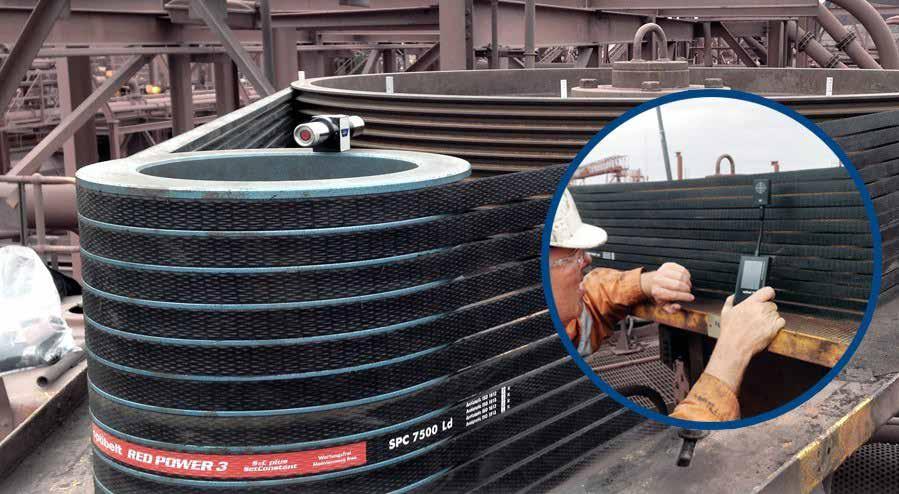
30 Mining Business Africa | January - February 2023 FEATURE
required on a drive design.
• Matched Set Guaranteed – Optibelts quality materials and specially developed Rotary Vulcanization manufacturing process ensure the tightest V-Belt length tolerance in the world, ensuring belts are manufactured and supplied in matched sets, regardless of the date of manufacture. Optibelts Set Constant [S=C Plus] V Belts will reduce inventory and maintenance costs and improve drive efficiency and production output.
• High Temperature range - - 30 to +100C as standard
• Up to 97% belt efficiency achievable
• High Service Life – minimum theoretical service life of 25,000hrs fair wear and tear.
• Increased pulley service life of up to 3 times, due to minimal operational belt slip
• Flame Resistant to DIN EN 60695-11-10 HB40 – Self Extinguishing
• The Optibelt Red Power 3 V-Belts are “DROP IN” on existing pulleys. No Special pulleys Required
• Increased productivity, reduced maintenance, increased belt service life by up to 6 times, and huge safety improvement.
Optimal performance in projects
In projects where they have been used, the Optibelt Red Power 3 V Belts have exhibited optimal performance, among several common cases, in high-impact load drives and slurry tailings lines.
In high-impact load drives, as commonly found in crusher and vibrating screen applications, the introduction of the Optibelt Red Power 3 has resulted in several advantages. Commonly cited are the following: drastically increased V belt service life, eliminated ‘belt slip’ and increased production throughput.
The installation of the v-belt on the slurry tailings line has resulted in due reduced belt slip. This has resulted in energy savings of around 9 – 10% recorded to pump the same amount of slurry as a drive fitted with conventional V Belts. Generally, an increase in productivity and less wear and tear on equipment were experienced.
Raring to go
In 2023, the team at Belting Ware are keen to replicate the successful installation of Optibelt Power3 Belts in African mining projects in the past few years. Based in Cape Town, South Africa, the vastly experienced team are raring to go.
Products of meticulous R&D
Manufactured by Optibelt GmbH, Optibelt Power3 Belts are a product of years of meticulous research and development (R&D). Optibelt GmbH is the pioneer of “Maintenance Free” V Belts, with the launch of the first series of Red Power belts in the late 1990s. This innovation was followed by the Red Power 2 and now the Red Power 3 series.
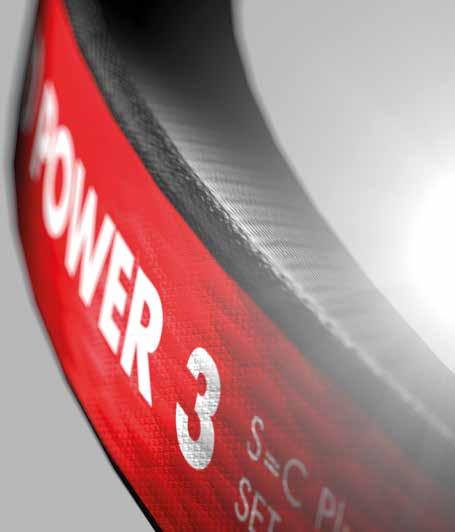
A wide range of services
The team at Belting Ware offer a wide range of services to cater for the unique needs of clients, mainly the following:
• Assistance with V and timing belt drive design for both New and Existing drives
• Belt Tensioning tools
• Belt drive alignment tools
• Drive pulley measuring gauges
Mining Business Africa | January - February 2023 31
PRODUCT PRODUCT maintenance-free up to 97 % efficient www.optibelt.com © ARNTZ OPTIBELT GROUP, GERMANY POWER TRANSMISSION optibelt RED POWER 3
The most cost-effective high performing heavy-duty drive belt - Optibelt RED POWER 3 maintenance free V-Belt
With the increased global downturn and market uncertainty, mining and industrial operators are continuously looking to reduce maintenance costs by increasing machinery uptime and performance. Every entity in the complex mining and industrial operational environment needs to be monitored, so as to create an efficient operation that cuts cost without compromising operational performance and safety.
This is where the OPTIBELT Red Power 3 V-belt range has proven to benefit mining and industrial operations by reducing operational costs
Optibelt is one of the world’s leading manufacturers of drive belts with a strong focus on giving customers best value for money through the lowest belt usage costs and highest productivity wherever possible.
Optibelt has always strived to continuously improve their product range to ensure that they are at the top end of the supply chain in terms of quality and reliability. The Optibelt Red Power 3 range has definitely lived up to this philosophy.
V BELTS: ASSET or CONSUMABLE??
Consumable
In a market familiar with low cost, poor performing V Drive belts, continuous maintenance and re-tensioning of drives has
become the norm. This, coupled with “matched set” challenges, Drive Location and Manpower issues, results in V belts being prematurely run to destruction and discarded, resulting in production losses, additional labour and safety issues and poor drive efficiency.
ASSET: Advantages of OPTIBELT RED POWER 3 V-Belts
• The “Maintenance Free” – Set and Forget technology: once installed and tensioned to required values, the Optibelt Red Power 3 will require no further re-tensioning or maintenance throughout their service life. These belts “Just do not slip”.
• A theoretical minimum service life of 25,000 hours, with a drive efficiency of up to 97%, is achievable, fair wear and tear considered. Energy savings of up to 10% have been recorded after installation of Red Power 3 V-Belts
• The Red Power 3 V-Belt can transmit up to 50% more power than conventional wedge belts, running on the same pulley diameter and at the same RPM, thereby reducing the number of belts required on a
drive, reducing weight and space requirements.
• Matched sets are guaranteed, irrespective of date of purchase. Red power 3 belts do NOT have to be stored in sets, thereby reducing stock inventory requirements
• Higher Temperature Range: -30C to +100C as standard
• V-Belt pulley service life is increased by up to 3 times due to negative operational belt slip.

• Available in all standard wedge belt profiles, SPZ., SPA., SPB., SPC., 3V[10N]., 5V[16N] and 8V[25N]
• No special pulleys required, “Drop in” into existing wedge belt pulleys.
The Optibelt Red Power 3 has been extensively tested in South African and International environments and is proven to work as stated.
For more information and testing reports on the Optibelt Red Power 3 V-Belts, please feel free to make contact with Optibelt African representative for local representation.
32 Mining Business Africa | January - February 2023 FEATURE
POWER TRANSMISSION
optibelt RED POWER 3 S=C Plus
HIGH PERFORMANCE WEDGE BELTS
optibelt RED POWER 3 S=C Plus V-belts and kraftbands are tested and approved in the and produce results that are really worth talking about:
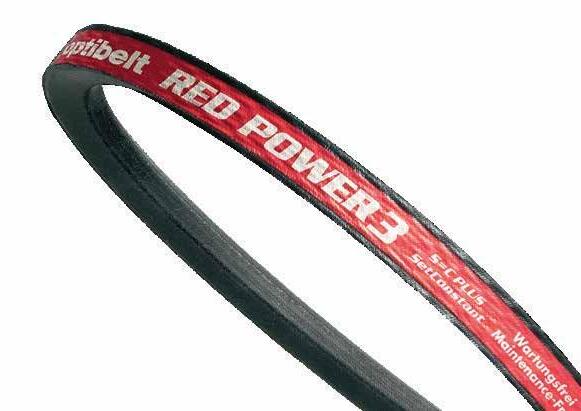
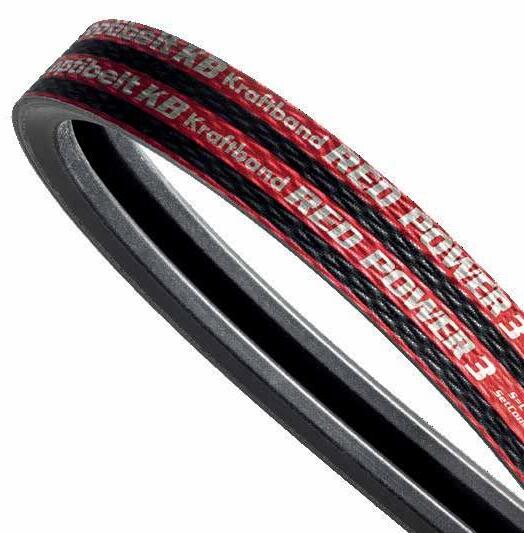
UP TO 50% HIGHER PERFORMANCE THAN STANDARD V-BELTS
Made Quality since 1872 in Germany

COST REDUCTION BY UP TO 35%
RETENSIONING NOT NECESSARY
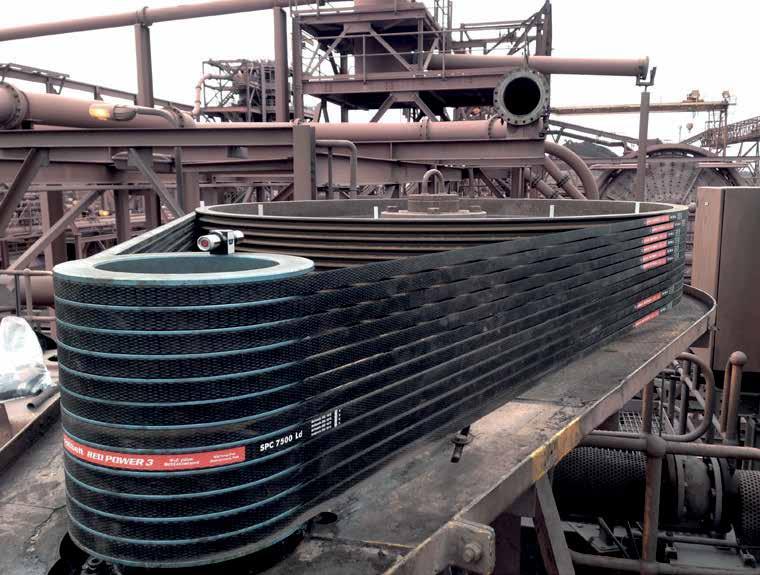
TEMPERATURE RANGE -30 °C TO +100 °C
SUITABLE FOR BACK BEND IDLERS + SMALLER DRIVES POSSIBLE
PLEASE SCAN ME FOR MORE INFORMATION ON THE RED POWER 3 SUCCESS STORIES:
Optibelt GmbH

© OPTIBELT GMBH, GERMANY
Corveyer Allee 15 T +49 5271 621 /optibelt 37671 Höxter F +49 5271 976200 /optibelt-gmbh Germany E southafrica@optibelt.com www.optibelt.com
Environmental Reporting Software for Emissions
Cloud-based and Automated Emissions Reporting, Improved Compliance
Economic Development Solutions (EDS) sees a compelling business case for the adoption of a cloud-based automated measuring and monitoring system of Green House Gas (GHG) emissions in contemporary mining. Recently, the multidisciplinary consultancy launched a mining-specific cloud-based automated measuring and monitoring system, which will help mining companies to manage and report on these harmful emissions.
Currently, buoyed by favourable commodity prices, mining companies are increasing production to get as much revenue as they can. Inevitably, in pursuit of this, their process plants are producing more Greenhouse Gas (GHG) emissions. Usually, this increases their tax burden and reporting obligation attributable to GHG emissions. For this reason, access to reliable data is vital.
Unfortunately, inherent setbacks are frequently encountered when traditional techniques are used for collecting, managing, and monitoring data. Inescapably, the unreliable data gathered results in poor emissions reporting. In this context, reference to traditional techniques is manual and by means of insecure and inaccurate data on spreadsheets.
Certainly, suitable techniques or tools must be used. Fortunately, so far, where they have been deployed in harsh environments, automated cloud-based measurement and reporting systems have excelled, enabling compliance with the regulation. So, EDS (Economic Development Solutions) sees a compelling business case for mining companies in adopting them. Recently, the company unveiled a cloud-based system specific to the requirements as laid down by the South African carbon tax act.
A necessity, not a luxury
Usually, mining companies tend to be conservative when it comes to embracing new technologies or methods, with cost implications
being a determining factor. Nevertheless, the team at EDS involved in the system’s deployment firmly believes that there should be no doubt that a cloud-based automated system is a necessity, not a luxury. This is given that, in the current environment, the challenges encountered with traditional techniques far outweigh the supposed benefits.
Challenges of traditional techniques
In an atmosphere of increased production, the limitations of traditional methods when applied to the complex structure or nature of mining operations have become very evident. This is given the typical complex structure or nature of mining operations.
Normally, mining operations are highly
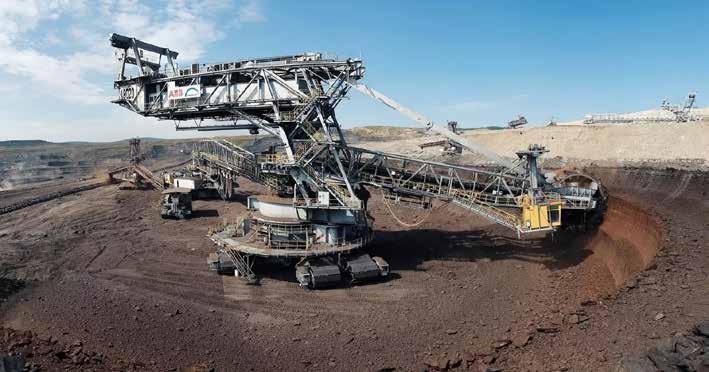
34 Mining Business Africa | January - February 2023
Emissions monitoring from mining equipment should not be based on guess work, but accurate data
FEATURE
complex operations that are composed of many interdependent activities, each of which has a data collection, capturing, monitoring, and reporting requirement. So, effective ESG reporting is critical.

Ideally, effective reporting should include supply chain, outsourced operations, in-house processing, as well as transport logistics. Yet, more often than not, constraints are experienced when using traditional techniques to perform vital measurement and monitoring tasks. Eckart Zollner, Head of Business Development at EDS, narrates a familiar scenario: “As data volumes grow, with increased production, data capturing and data analysis suffer from delays and inaccuracies. Consequently, mining companies will find it hard to keep reporting accurate and on time.”
In a word, traditional data collection and reporting methods are time-consuming, prone to human error, and hard to scale with increased production. As you would expect, the odds of noncompliance are always high.
Cloud-based automated measurement and reporting system
In contrast, there should be no question that, when deployed correctly, an automated measurement and reporting system redresses the inherent limitations of traditional techniques, filling the void.
In demonstrating the significance of cloudbased automated measurement and monitoring, Zollner mentions automation and consolidation as features that make EDS’s solution as the perfect fit.
“Thanks to its scope of capabilities, the cloud-based system allows the automation of data capturing, analysis, monitoring, and reporting across an unlimited number of data input sources. Moreover, it can be consolidated to provide a complete overview of reporting and data visualisation across many layers of activities inside the organisation,” he explains. In a nutshell, mostly importantly, the cloudbased solution provides visibility across multiple elements as well as a responsible parent entity.
Achieving compliance and optimal operational performance
Ultimately, through implementing the cloudbased system, the team at EDS is confident that mining companies will simplify the complex tasks of environmental monitoring and measurement, achieving compliance and optimal operational performance. They are committed to replicating the success registered in deploying the consultancy’s other core solutions to mining companies in the area of environmental monitoring and measurement.
Based in Johannesburg, the EDS team members have over 35 years of collective
experience within the B-BBEE, Economic Transformation, Strategy, Business Development, Monitoring and Evaluation, Compliance Reporting, and Project Management sphere.
Fully customisable and configurable
While all mining operations are by their nature complex, in reality, every mine is unique, and so are the challenges it faces, with emissions monitoring and measuring being no exception.
Relating to measuring and monitoring, inherently, mining companies have different needs. Given that, Zollner assures mining companies that EDS’s system is fully customisable and configurable concerning the specific input data, processes, and materials deployed. “Clients have two options. First, they can be trained in the configuration themselves or work with a third party. Another way is to work with a thirdparty consultant to assist in the configuration and dynamic adaptation of the data sources in line with any potential material or process fluctuations,” he indicates.
Mining Business Africa | January - February 2023 35
Engineering a Reliable, Durable, Effective & Efficient Borehole Solution
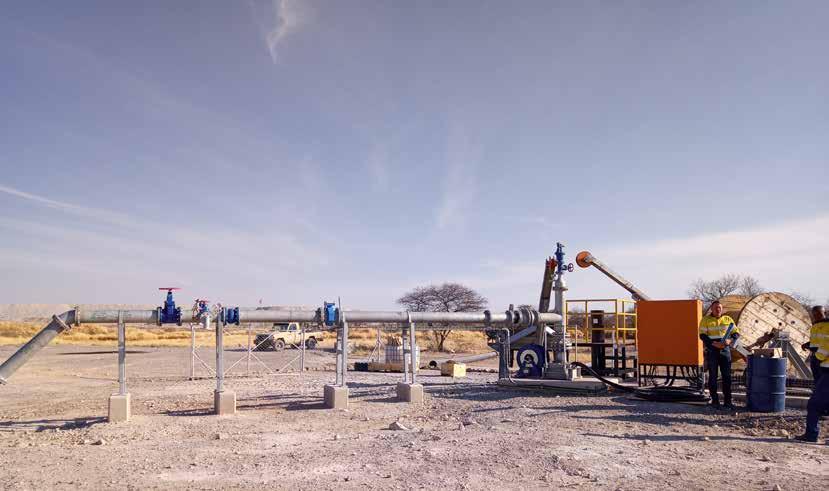
By combining its flagship ZSM connection with STÜWA’s slotted well bridge screen and other screens, CHPPS has unlocked a reliable, durable and effective solution to the common problem of well/borehole development for mines and other industries in Africa. The launch - when mines are ramping up production and need reliable sources of pure water - could not have been more perfectly timed.
Most mines in DRC and Zambia are overwhelmed with underground water. KCM in Zambia is the wettest mine in the World, remote areas construct boreholes to access underground water from areas they identify. However, for boreholes to deliver longevity they must pump pure water – which is achieved by filtration i.e. screens keeping solids away from pumps - and the only equipment that has proven to be durable and effective in tough conditions should be employed.
Thus, to deliver the best possible borehole solution to mining companies, Carl Hamm selected STÜWA as the ideal partner.
After being asked about the decision to partner with STÜWA, Chris Munnick, CEO of Carl Hamm PPS, justifies precisely,” After extensive research, it was a no-brainer.”
Carl Hamm PPS, the supplier of specialised pumps and pipes for the agricultural and mining industries, is widely respected for its flagship flangeless high-pressure ZSM riser connection. This is an innovation which has set the industry benchmark in dewatering applications. And so, with its track record in providing relevant solutions, it was only natural that CHPPS needed an organisation that shared its values.
Perfect partnership
In STÜWA, there could not have been a more perfect partner to enable CHPPS to realise the goal to deliver the best possible borehole/ well solutions. STÜWA is synonymous with the universally-endorsed slotted bridge well screen.
The Stuwa slotted-bridge well screen
Typically, a well screen is a part of the casing at the bottom of a well or borehole that stabilises the structure of the hole, while also preventing
debris such as the rocks and dirt surrounding the borehole wall from entering the water supply system. But, there is no question that STÜWA’s slotted bridge well screen blazes a trail.
Particularly, Chris Munnick, mentions the design of the screen and the quality of the material as two elements that make the well screen stand out.
The shape of the holes in the screen renders the slotted bridge well-screen effective. The holes appear to have bridge-like structures over them, ensuring that water can still pass through the holes while still preventing any rocks and sand from doing the same.
All the more worth underlining is that the slotted bridge well screen is produced according to internal STÜWA standards. Munnick describes STÜWA bridge slotted screens and casings as ‘at the cutting edge when it comes to stability and material quality’. “The well screen stabilises the aquifer strata and helps water flow into the borehole at a consistent rate, therefore protecting the area around it.”
Currently, the well screens are available in different size ranges to cater for client needs.
Depending on the wall thickness of each well screen, slot widths are approximately 0,5 mm or more. The wall itself can be up to a thickness of 12 mm. Screens are available in plastic and stainless steel, making them rust-resistant and durable.
The ZSM riser connection
The ZSM connection perfectly complements STÜWA’s bridge-slotted well screens. It has a restraining pin that slides into the slot to form a perfect seal. This pin acts as a hook that holds the opposite part of the connection perfectly in place. In addition, unlike screw connections,
ZSM has no grooves. Specifically, due to the material of construction, as well as the design and engineering, the ZSM riser connection has several features that are ideal for boreholes/ wells. Mainly, these are:
• Quick and easy to install
Several unique features make the coupling quick and easy to install. The reduced diameter of the ZSM connection is the ideal choice for any project where there is little wiggle room. The Stuwa pipes can be installed into wells of up to 300 m deep and 250 mm in diameter. Carl Hamm has designs in excess of 1500m deep with the ZSM available up to 1400 mm in diameter.
• Sand and waterproof
The tight seal ring prevents sand and water from making their way in.
• Handling high pressure
Last but not least, the Stuwa ZSM riser connection can handle a lot of pressure — up to 40 bar! The Carl Hamm ZSM can be used for more than 150 bar.
Adequately resourced
Largely, in combining its flagship ZSM riser connection with STÜWA’s slotted-bridge well screen, CHPPS has engineered a reliable, durable and effective borehole solution. The company is now adequately resourced to solve complex challenges that industries in Africa are confronted with in well/borehole construction. Most importantly, in the bigger scheme of things, its partnership with STÜWA underscores CHPPS’s quest to increase the scope of turnkey solutions it provides to clients under one roof.
36 Mining Business Africa | January - February 2023
FEATURE
Ready to exceed customer expectations
Whenever mining companies seek a reliable provider of turnkey dewatering solutions for their surface and underground mining operations, Carl Hamm has always emerged as a ‘go-to’ company. The company’s distinctive attributes of Competence, Experience, Innovative thinking, Modern production facilities and Motivated employees that form the basis of the company’s services always tick all the right boxes.
Now, with a forward-thinking mindset, the company is aiming at exceeding customer expectations in 2023. Consequently, in pursuit of this objective, the company’s team of application engineers clarifies that it won’t alter the winning formula, but it will strive to keep pace with evolving needs in the area of service excellence.
Committed to delivery
This position is informed by the observation that, with increasing production on their minds, clients in the mining sector expect Carl Hamm to raise the bar. Besides, the company is keen to add new clients to its growing portfolio. “We have excelled in the past, by going the extra mile. But, as always, we are not resting on our laurels. Constant improvement remains part of our ethos in 2023 and beyond,” the team brief Mining Business Africa. They underline the company’s commitment to delivering a complete turnkey solution through a flexible approach; devotion to safety and quality assurance, as well as constant innovation.
• Complete turnkey solution
CHPPS’s turnkey solution brings the convenience of a one-stop shop for dewatering systems to the customer. Its complete turnkey solution (from pump to discharge) is the main scope of supply. This includes but is not limited to electrical switchgear, variable speed drives, system integration, e-house solutions and all the required horizontal piping and valves.
As part of the turnkey package, CHPPS offers on-site commissioning and troubleshooting assistance for all supplied equipment, laser alignment, condition or vibration analysis, and flow rate measuring can be obtained if required. Additionally, the company can facilitate workshop pump rebuilds, repairs, and supervision. Training can be arranged if a client’s requirement needs a full understanding of the use of their products.
• Flexible approach
CHPPS’s approach is informed by the recognition that the requirements of mining companies are unique – some complex, others simple. And so, it ensures that its solutions are delivered as per the client’s requirements.
Regarding the approach, the team expound: “We provide differentiated products, advisory
expertise and best-of-breed training to plan, install and assure the efficient running of engineered supplied products. Furthermore, we offer competitively priced conceptual project planning assistance - with everything from large bulk water flow systems to closed, and even flooded mine dewatering. Over and beyond, we offer on-site supervision and training when installations are done.”
• Devotion to quality assurance
Besides the relevance of its turnkey solutions
and the approach to delivery, CHPSS’s products blaze a trail in devotion to safety and high-quality standards. This is evident in its ZSM Coupling, which is geared towards longevity and high efficiency. “We are proud to assert that Carl Hamm ZSM coupling Quality assurance and safety standards surpass those of products in the similar niche market from competitors,” the team affirm.
• Constant innovation
CHPPS is cognizant of the ever-shifting client preferences. That is why through constant innovation, the company keeps up with contemporary technological trends in miningspecific dewatering. It is continuously adding new supportive products from its industry partners and concentrates on those products that support and complement its scope of supply.
Last but not least, Carl Hamm tells mining companies, as they are increasing production, to engage it for their respective dewatering requirements in 2023 and beyond. “We have built a reputation for competence, experience, innovative thinking, modern production and motivated employees. Clients benefit from a strong partner who offers extensive expertise to meet specific requirements from conceptual planning through professional production to ontime delivery,” the team say.
CHPSS’s enviable track record reflects the confidence that clients have in its turnkey solutions. True to form, currently, the company is in the process of completing three large Free hanging High-pressure pipelines for dewatering systems i.e. 2 x 450 and DN600 ZSM system.
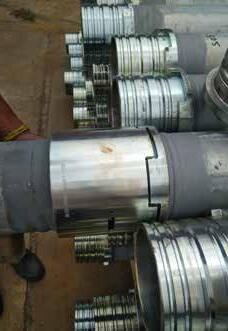
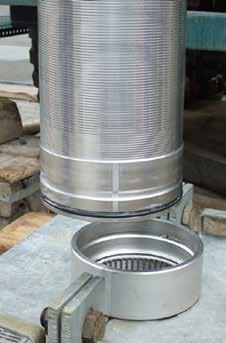
Fruitful partnerships
Immeasurably, the team are greatly indebted to the fruitful partnership CHPPS has forged with globally-acclaimed technology specialists, mainly Stüwa, Düchting, Feluwa & SICcast. The company looks forward to drawing on existing partnerships in pursuit of client’s industryspecific solutions.
For more information on the products and services that Carl Hamm provides, contact Chris Munnick on + 27 72 256 0926 or send an e-mail to chris@carlhamm.co.za. Visit their website at www.carl-hamm.co.za
Mining Business Africa | January - February 2023 37
STÜWA’s Bridge Screen
The ZSM riser connection
Second-hand yellow equipment procurement and disposal for mining houses & contractors
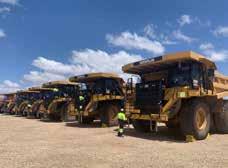

Business as usual in 2023
It may take time to narrow the gap between the global demand and supply of spare parts. The possibility of a hard lockdown in China, where the bulk of products is sourced, has dashed any hopes of the resumption of mass production. In addition, global inflation, fuelled by increasing rising energy prices, will continue to occasion an increase in shipping costs, which will result in high equipment and spare parts costs. And, due to these two factors, MHS Plant & Equipment predicts, that increasingly, mining companies will turn towards procuring second-hand yellow equipment.
The Managing Director of MHS Plant & Equipment, Conrad Smith, does not proclaim to have in his possession a crystal ball to tell the trajectory of the secondhand yellow equipment in 2023 and beyond. Nevertheless, based on the impact of current developments in the global economy on the equipment and spare parts sector, he foresees a repetition of the 2022 scenario.
In this atmosphere, he looks forward to MHS Plant & Equipment growing its core business portfolios of second-hand yellow equipment sales and equipment rental.
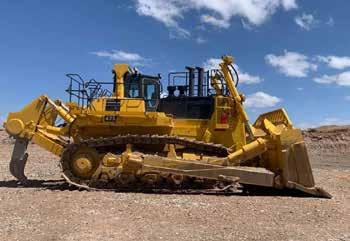
“It will generally be more of the same,” he states, highlighting the supply chain disruption and global inflation heavily impacting the management of equipment inventory of mining companies.

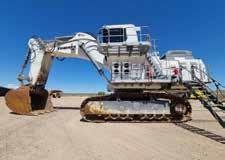
• The supply chain disruption
As this publication heads to press, due to the rise in COVID-19 infection, there is a huge possibility of the imposition of hard lockdown COVID-19 restrictions in China. This has dashed initial expectations of the resumption of mass production in the country.
Since the first quarter of 2003, hard lockdowns have caused costly disruption of the operations of equipment factories in China, with massive ramifications across various industries globally.
Observing the recent development, Smith says it reinforces the moral of the risk of putting
all their eggs in one basket in the supply chain and the importance of having contingency plans firmly in place. Based on this, he sees secondhand yellow equipment remaining a proverbial low-hanging fruit for industries seeking a viable alternative to filling the gap in equipment supply.
• The impact of global inflation
Supply is not the only factor shaping current purchasing trends.
In 2022, prohibitive equipment prices, mainly on the account of astronomical shipping costs, compelled mining companies to shift to the second-hand yellow equipment market to replenish their inventory. What was witnessed was that clients deferred new equipment purchases and elected to retain their old stock. Instead of new purchases, they explored the cost-effective option of the second-hand yellow equipment market.
Looking forward to 2023, Smith expects more of the same in equipment purchase trends with the war in Ukraine showing no sign of ending soon. Concurring with his viewpoint, a World Bank forecast for 2023 paints a gloomy picture of the world economy, against the backdrop of record-high energy inflation in western countries. “Global growth is expected to decelerate markedly from 4.1 per cent in 2022 and 3.2 per cent in 2023,” notes the report.
Equipment rental
MHS views equipment rental continuing as a
FEATURE
38 Mining Business Africa | November - December 2022
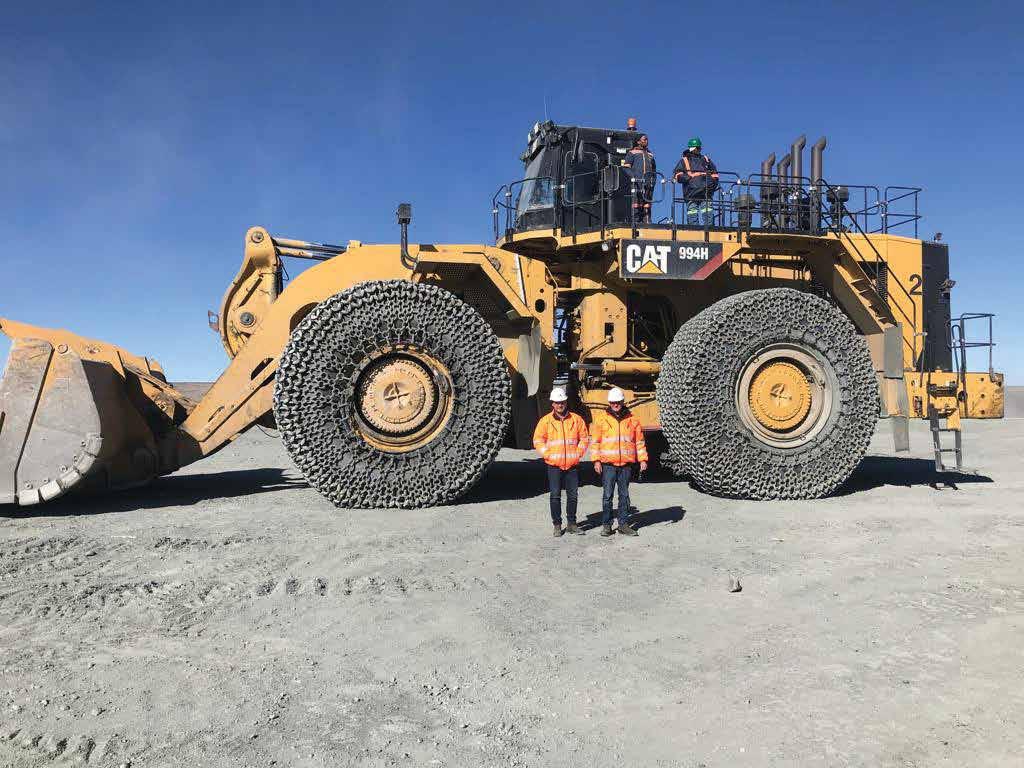




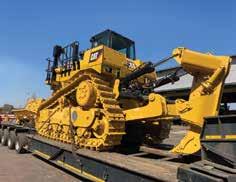
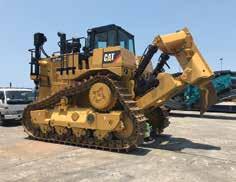
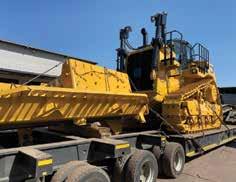
Tel: +27 11 466 9293 | +27 82 781 9481 info@mhsplant.co.za | mhsequipment.com Your procurement and disposal specialists. Offering a turnkey solution to mine or site closures. We specialise in handling the entire disposal process, from the inventory inspection, valuations and marketing to the sales and delivery process, which entails getting topreturns for your assets, handling all dismantling,land and ocean freight, as well as marine insurance. Use our extensive international client base exposure to ensure the best possible returns for your assets.
strong growth avenue in 2023, especially in South Africa where it is domiciled. This is based on a recent trend.
In 2022, opportunities opened up for small contractors, following the closure of some big contractors to mining companies (only five remained at the last count). So, MHS views this development as a potentially lucrative market for its second-hand yellow equipment. ‘Currently, there is a gap in the market for small and medium-sized players which discerning providers of second-hand equipment should be able to service,” Smith is upbeat
Perfectly positioned
Given the above mentioned developments, Smith declares that MHS is adequately resourced to meet the increase in demand for yellow equipment – both in equipment purchases and rental - as it has always done in recent years. Specifically, he mentions access to equipment from a diverse database of suppliers worldwide which has been built over the past twenty-five years, as a strong point in the area. This is above and beyond the know-how of helping mining companies get the best value for money from the disposal of their redundant stock and new purchases.
As to handling requisite logistics, the client can rest assured that everything is in the capable hands of its experienced team. The team can handle the entire process from start to finish - procurement, shipping, marine insurance, clearing and forwarding to delivery and commissioning on site.
In equipment rental, MHS is going all-out to seek innovative ways of meeting the needs of upcoming contractors, especially black-owned who may be under-resourced. In particular, it has created tailor-made packages for selected smaller Black Economic Empowerment (BEE) groups and communities that work for the large mining Houses.
Regarding black-owned businesses, the company has taken a broad approach, encompassing assisting with equipment, training and expertise that guarantee great ‘uptimes’ for the sites. “There are various models which we offer from normal dry rate rental (no operators) through to a Rent to Own model (with MHS support). This model is especially attractive and supported by the blue-chip mining houses, assisting them to empower local communities without any disruptions to their operations,” Smith expounds. “We have devised what we hasten to call a model of sustainable empowerment.”
While MHS Plant & Equipment is relishing emerging opportunities, when persuaded to comment on the possibility of being overwhelmed by increased demand, Smith says: “We have already proven that, perfectly positioned, we can handle increased orders from clients worldwide. As we did in 2022, in 2023, it will be business as usual.”
Based in Midrand, Johannesburg, MHS Plant & Equipment specialises in the import and export of new and used mining and construction equipment. The company buys and sells construction and mining equipment throughout Africa, Australia and the Americas. It provides solutions to liquidate assets for mining and financial institutions on a global scale.
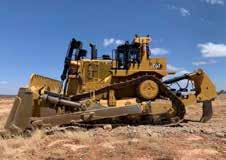

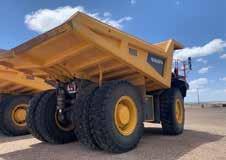
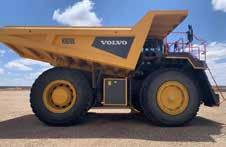

International company shift to local companies
There is a mindset shift, witnessed in 2022, noticeably, amongst Australian and European companies, augurs well for the company’s immediate and medium-term growth plans. Interestingly, the companies have shifted from engaging international suppliers to local players for their yellow equipment disposal or procurement requirements. “International companies have noticed the convenience of using local players with experience on the ground. We are keen to play a role in meeting their specific needs in yellow metal equipment procurement or disposal,” Smith underlines.
What gives MHS the edge as the go-to supplier/seller of second-hand yellow equipment is the experience of the common risks encountered in Africa. The risks include poor infrastructure, political instability and red tape involved in getting the necessary paperwork.
Predictable redundant asset disposal
MHS guarantees that it can carry out disposal of the redundant equipment smoothly and on time, ensuring that clients get real value. This is thanks to its extensive database of potential buyers of the equipment and the capacity to deal with the buyers effectively.

“We ensure transparency in the transaction process. Our transactions are more predictable than unreserved options (in-house asset disposal). This eliminates sales fees and buyer’s commission. We offer the most cost-effective option,” states Smith.
“As we know models which sell well into a territory or the region, we do assure the sellers of the best possible returns at all times,” Smith adds.
Through unreserved auctions, sales attract an 8 to 10% fee for the sale, plus a 10% buyer’s commission (almost 20%), before factoring in any marketing costs. The buyers take this 20%, plus the cost to relocate the equipment into consideration when bidding.
40 Mining Business Africa | January - February 2023 FEATURE
Mineware Consulting
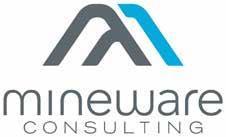
Sampling software module - visually plotting ore reserves.
Syncromine Sampling software assists in capturing spatial data to be used in the Ore Reserve Management process.
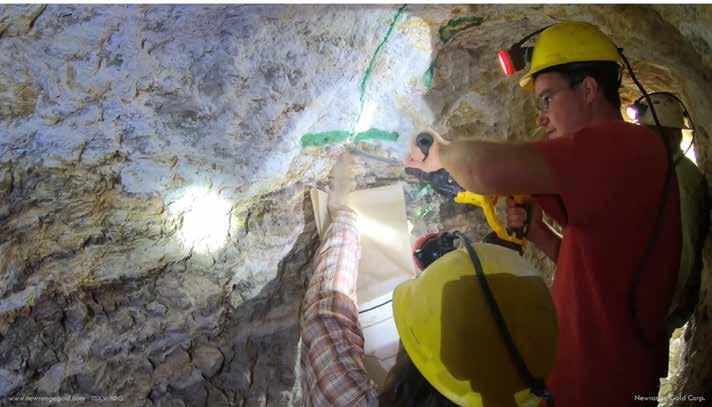
The MineWare sampling module is a brandnew product that assists mines with reports and referencing of ore bodies. This system is extremely simple to use and install, offering information in an easy-to-read graphic interface. It can be used as a standalone product, or integrated with ease into existing reporting systems. There is currently no other comparable software product available that fills this niche in the mining process.
Sampling and mapping ore deposits is an integral part of any mine’s planning. Currently mining companies see the need to upgrade their legacy sampling software, much of which is outdated and not expandable. Mineware’s sampling module, part of their flagship Syncromine software, is unique in that, while it can be used to replace older systems, it also
has the ability to combine with other systems, in effect allowing them to integrate more seamlessly with a number of existing reporting systems. This means less downtime, and money saved.
Sycromine’s Sampling module offers users a simple system that can be installed on a local computer or a central server used by the Mineral Resource Department.
This module can be operational in as little as a week. The program is installed and configured, mineral types, standard material and ticketing standards are entered. Then you are good to go!
Once surveyors have drawn samples, the position of the samples is captured spatially within the sampling module’s graphic interface. The mineral content is then added to each mineral to calculate an accumulated channel
of core values. This information can then be seamlessly exported using the built-in synchronization method and customization tools. Pull quote<Although this system is currently tailored towards the mining sector, it can be used by any client requiring spatial or non-spatial data of work sampled. The value of this software is mapping of the spatial element between samples.
The sampling module offers a mine ease of use and straightforward access to referencing information. Mines are also assured of quality control on data capturing. This system is unique in that it can integrate with existing legacy systems, while enhancing the overall user experience.
FEATURE
Cnr of Pelindaba Rd and Hertford Junction Lanseria Johannesburg, 1748 info@mineware.co.za www.mineware.co.za 011 888 2116
Safe & Sustainable Tailings Management
Safe and Sustainable Tailings Management, Compliant Mining
Tailings production is inherent to mining and metals processing. Ensuring their safe and sustainable management should be viewed as a burden, but a benefit in the bigger scheme of things - compliance with Environment, Social and Governance (ESG). Thankfully, with clarity, the global standard on tailings management provides the scope of key elements to be adopted and implemented.
Catastrophic tailings dam failures at Brumadinho (Brazil) in 2019, Samarco (Brazil) in 2015 and Mount Polley (Canada) in 2014 and similar ones that have occurred in the past few years typify what can go wrong when best practice in tailings management is ignored or neglected in mining operations. Brutally, the accidents exposed inherent systemic gaps in how mining companies approach tailings management.

As expected, following the events, there is an increased obligation on mining companies to ensure safe and sustainable tailings management. There is more emphasis on best practice in tailings storage facilities, as well as
water-use reduction and water storage.
The question is: How can mining companies achieve safe and sustainable tailings management through tailings storage facilities, water-use reduction, and water storage?
Global Industry Standard on Tailings Management
The Global Industry Standard on Tailings Management (the Standard) provides guidelines for mining companies to reference. It was developed by the United Nations Environment Programme (UNEP), Principles for Responsible Investment (PRI) and International Council on Mining and Metals (ICMM through an
independent process – the Global Tailings Review (GTR).
The Standard applies to existing and future tailings facilities, wherever they are and whoever operates them. Specifically, it is aimed at strengthening current practices in the mining industry. It embodies social, environmental, local economic and technical considerations.
No stone unturned
The Standard leaves no stone unturned. It calls for tailings management to be effective throughout the life of an operation (the entire tailings facility lifecycle) - from site selection, design and construction, through management
42 Mining Business Africa | January - February 2023
FEATURE
Spotlight on Sustainable Mining - Best Practices in the Safe and Sustainable Management of Tailings and Mine Residue
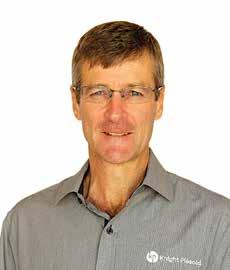





Weall need mining by-products in the world in which we, and with every mine, the extraction of the metals and minerals results in a process residue or tailings. However, there is more and more pressure being placed on the industry to minimise mine residue, and/or their impacts. Sustainable mining must either put the mine residues back where they came from, find a market/use for it, and/or create a land-use equal or better than was in place prior to mining. This typically requires a waste hierarchy approach of avoidance, conversion to a new use, minimisation, re-use or storage. Such practical examples include;
• Traditional surface “disposal” in tailings storage facilities (TSFs), which should be strongly challenged at the design stage to evaluate alternatives, and if surface storage is selected, it must be designed such that it does not pose a threat during operation or post-closure. New technology in this field revolves around dewatering of the tailings using filtration and then dry stacking it, or co-disposing it with overburden material. These options do little to minimise waste, but rather try to reduce the footprint, failure and closure risks.
• Re-processing of old TSFs is common practice as they have become resources as processing technology has improved. However, this processed tailings has to be stacked somewhere, unless a new use can be found for it, such as in construction materials. The benefit of reprocessing is that multiple TSFs can be re-mined and combined into one new TSF, with overall smaller impact, provided rehabilitation of the old footprints and the new TSF can be done sustainably.
• In-pit disposal of tailings is also common practice, but is only possible once the orebody has been mined out, and





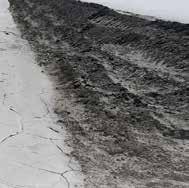

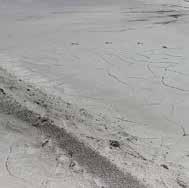


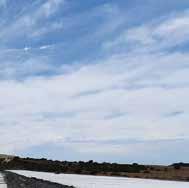

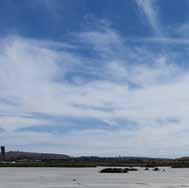

any remaining ore is not considered feasible and can be sterilised. Surface and in-pit TSFs will be needed in this case.
• Backfilling of underground mines is good practice, and can be done simultaneously with mining, either for support and strata control, or simply to fill voids. This can however only account for about 45% of the tonnage due to the loose state the tailings is placed compared to the density of rock.
• Ore and waste sorting is a method that can be used to minimise the volume of ore that is crushed and processed, using various density, magnetics, X-ray or other technologies to separate it out. This may not reduce the overall volume of waste, but does reduce energy and water consumption for processing, and land area occupied by TSFs.
• Robotic mining that only extracts the ore, or ore with as little waste as possible. Some mining methods and equipment already target this approach, but many are not as selective.
• In-situ mining or processing, by leaching the minerals in-situ and abstracting the metal/mineral rich solution. However this can leave behind a contaminated “depleted orebody” due to the reagent used to leach the ore, and must be rehabilitated in-situ.
Knight Piésold can offer a full range of design capabilities for the safe management of the surface TSF options to achieve the most sustainable solution. The location of each mine affects the optimal solution, as well as the type and depth of the orebody, and the mining and processing method. More and more mining companies are considering new technologies and safer TSFs than before, not only because of the consequences associated with hydraulic deposition, but because of the need to design for closure, and to secure licences to operate.
FEATURE
1 Discovery Pl, The Ridge, Sandton, 2196 | +27 11 806 7111
FEATURE
(operating) and monitoring, to decommissioning tailings facilities (closure and post-closure) in conformance with the (GISTM).
Most importantly, the Standard increases accountability on the part of mining companies regarding their tailings management, on the one hand, and widens the scope for independent oversight, on the other.
‘The sum of many parts’
Effective safe and sustainable tailings management is a sum of many parts. Mining companies can utilise different technologies (innovations) to achieve safe and sustainable tailings management that are readily available at their disposal across the mining cycle.
An example of strategic interventions
Interestingly, globally, global mining companies have embraced strategic interventions to achieve safe and sustainable tailings management. The following steps from Harmony Gold outline the basic steps mines must follow:
• Freeboard control
This entails the maintenance of safe operating water levels on top of the TSF. Drone technology is used to support regular freeboard
Technologies in isolation cannot suffice. And so, tailings professionals should continuously stay abreast of the latest trends in tailings management.
Burden or benefit?
At the end of the day, regarding the adoption and prudent application of the Standard, the buck stops with mining companies themselves. Sustainable tailings management ensures compliance with best practice in Environment, Social and Governance (ESG) which is core to their operations in the contemporary atmosphere. For this reason, there is no room for selective application.
There is a huge price for laxity as recent
surveillance.
• Water management
Water management to avoid excessive water accumulation in the facilities

• Maintaining stability and safety
Re-mining TSF from the top to the bottom of the face to minimise the risk of sloughing and inundation. In addition, maintaining a stable slope face by stopping limits on the monitoring
trends indicate. The ICMM Warns: “If not managed properly, tailings can have chronic adverse impacts on health, wellbeing and environmental integrity, with pollution from effluent and dust emissions being potentially toxic to humans, animals and plants.”
To a mining company, the stakes are high. It results in loss of operating licence and exorbitant sums in penalties (while the culprit may be deep-pocketed, the reputational damage can be irretrievable).
At the end of the day, a rational decision that is good for long-term sustainability has to be made regarding tailings management during a mining operation’s life cycle.
gun that controls the angles.
• Erosion controls
• Monitoring and control measures are implemented to ensure compliance. Extensive audits are carried out to indicate compliance with the tailings facility.
• Fallout dust management
• Emergency preparedness and response
44 Mining Business Africa | January - February 2023
MBA Half Page Horizontal Ad - Water Footprint.indd 1 2/11/22 5:06 PM
Expand your network with attendees from 120+ countries
1,100+ exhibitors showcasing the best in the industry
Hundreds of hours of programming presented by industry experts

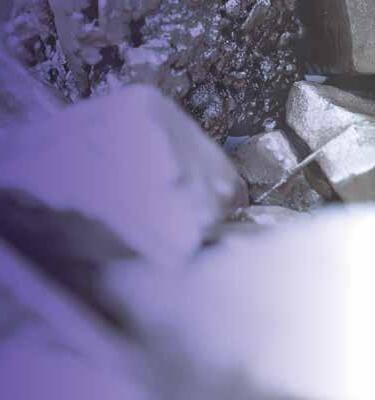

Engage with private, retail and institutional investors and senior executives




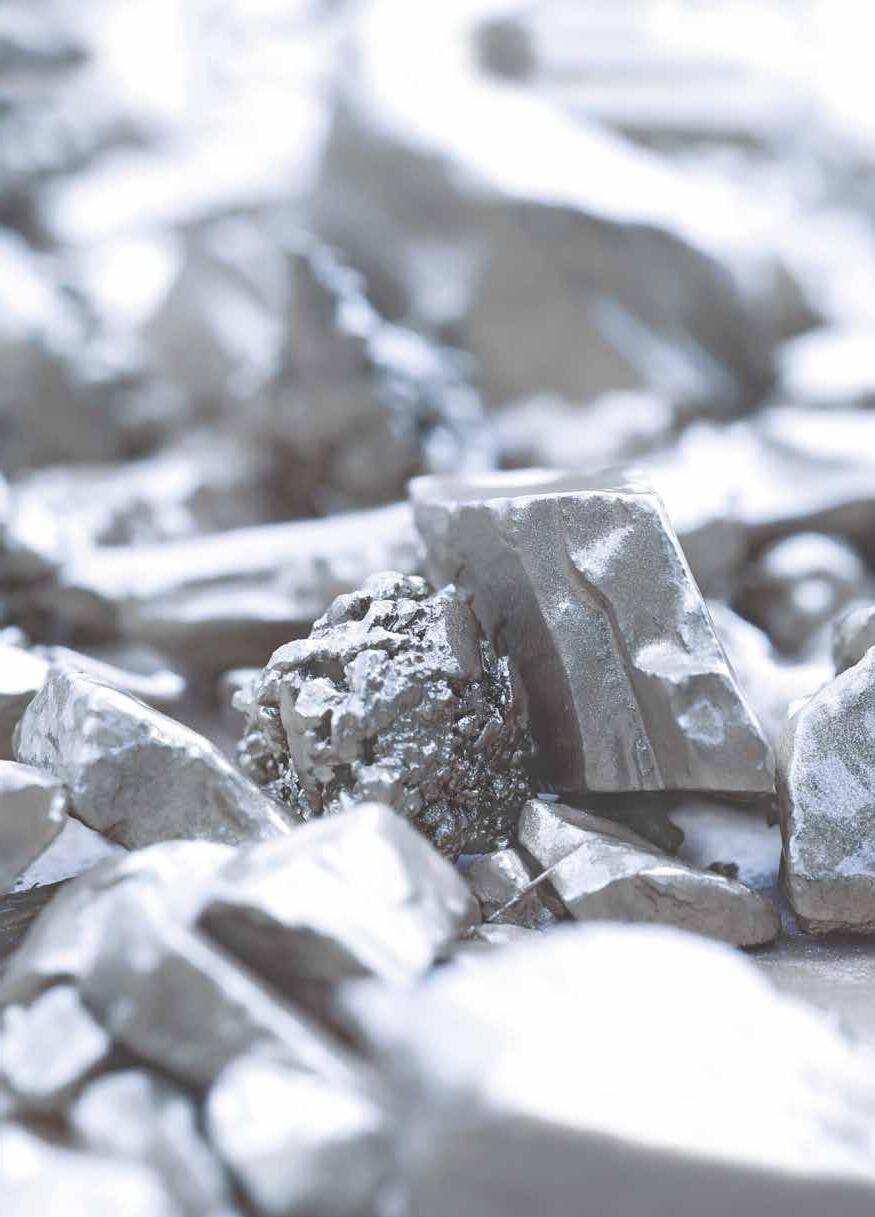
REGISTER AT pdac.ca/convention | #PDAC2023 Metro Toronto Convention Centre, Toronto, Canada MARCH 5 - 8
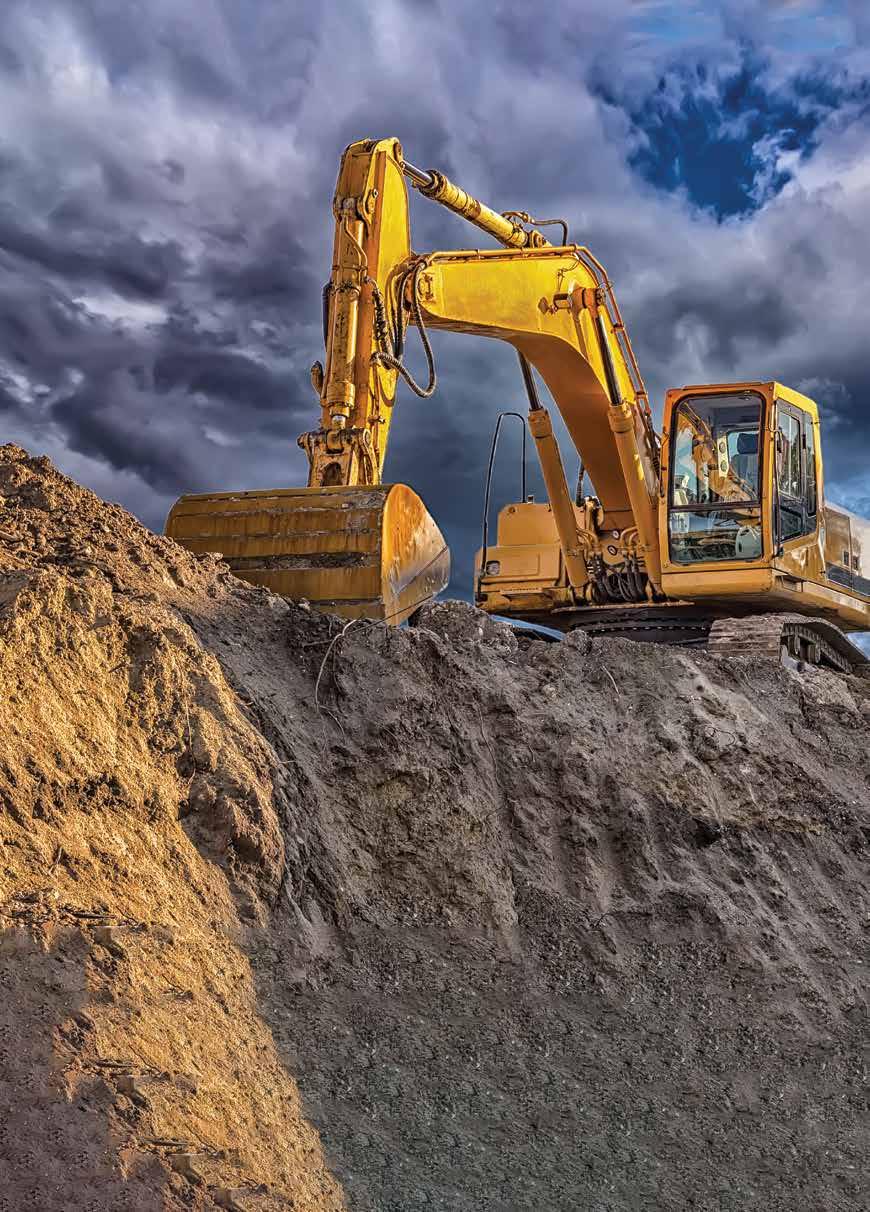
Driver Identification & Driving Behaviour Monitoring Engine Performance Monitoring (RPM & Idling) Collision Avoidance Sensors Fuel Level & Consumption Monitoring Iris Camera Solution Front-Back-Side Facing Camera Option Onboard Weighing Breathalyser Tip Sensor Improve your mining operation with dynamic Ctrack Solutions. www.ctrack.co.za | sales@ctrack.co.za | Call Centre: +27 (0)860 333 444 Always Visible
Features
Improving Safety in Underground Mining with LTE Technology

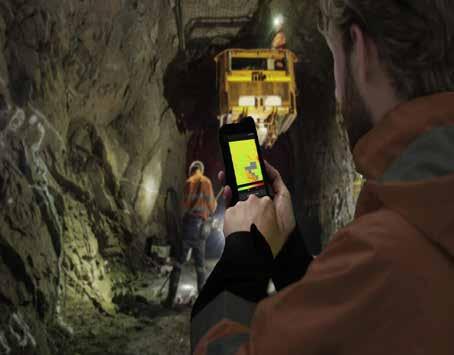 By: Michelle Murray
By: Michelle Murray
Underground mining can be a challenging environment for communication due to the presence of rock, dirt, and other materials that can interfere with or block radio signals, thus making technological improvements to underground environments important to ensure operations are safe, reliable, and efficient. One solution to this problem is to upgrade your underground operations by integrating Long-Term Evolution (LTE) communications.
LTE is a wireless communication standard that operates in the licensed frequency bands between 700 MHz and 6GHz. It can provide good coverage in most environments. In the mining industry, LTE is now being used across the globe to increase operational capabilities by providing a safe and secure way for miners to, access data, monitor ventilation, detect gasses, operate equipment, and stay connected to one another through handheld devices and real-time personnel tracking.
There are several different ways that LTE can be deployed in underground mining environments, depending on the specific needs and requirements of the client. One common approach is to use a network of underground Remote Radio Units, which are installed at strategic locations throughout the mine. By utilizing our world renown Leaky Feeder System, Becker Mining Systems brings an effective alternative to enabling LTE connectivity in mines through the integration of our smartcom® LTE Amplifiers and
passives which offer a robust, costeffective option to extend the coverage of the RRUs.

By progressing operations towards LTE, we can provide mine-wide access to the data pipe and take advantage of its high-speed and very low latency to automate processes in underground mining which can greatly improve personnel safety by reducing the need for human workers to perform dangerous tasks. For example, the remote control or autonomous operation of mining equipment and haulage systems can be implemented to mine and transport ore and waste, while also improving situational awareness by providing real-time data on the location and status of personnel and equipment through tagging and tracking, thereby decreasing response times in case of emergency.
In conclusion, LTE technology can be a valuable tool in improving safety in underground mining operations. The improved communication and real-time monitoring provided by these networks, as well as the use of machine learning, can help to keep workers and equipment safe. As technology continues to advance, it is likely that we will see even more ways in which LTE networks can be used to improve safety in mines.
For more information on how Becker Mining Systems can assist in implementing an LTE system within your mine. Please contact us at +1 705-674-8111 or info@ca.becker-mining.com.
Mining Business Africa | January - February 2023 47
FEATURE
Flexible Network Coverage Faster Performance Robust + Reliable More Secure The new LTE Leaky Feeder offering from Becker Mining Systems brings an effective alternative to enabling LTE connectivity in mines. www.becker-mining.com info@ca.becker-mining.com +1 705-308-2455 CONTACT US TO LEARN MORE LTE STAY CONNECTED WHY Underground environments can be challenging for voice & data. Communication is critical for overall team safety & operations. Creating cost effective solutions, and enabling automation for remote processes.
FEATURE
Turn data from sorting into greater profitability
Free-to-download publication spotlights how sorting data can now be easily accessed and understood to gain commercial advantage

TOMRA Mining has published a new eBook to help mines enhance efficiencies and profitability by using information gathered by sorting machines. The easy-to-read, 21-page booklet, titled ‘When Sorters Become Data Generating Machines’, explains how businesses can “connect to possibilities” with the TOMRA Insight data platform, and the competitive advantages this gives.
The eBook starts by reminding us that sensors in sorting machines can do a lot more than identify whether products or materials on a line should be accepted or rejected. As the book says: “They collect and store every piece of information about what they see. And this information can tell you a lot about how your machine is performing, about the products that pass through it, and your process.”
The eBook makes the encouraging point that turning TOMRA’s sorters into connected devices isn’t difficult, and businesses can benefit from digital sorting data with minimal impact - all that’s needed is wiring and a stable internet connection. The data solution’s software stores and processes the data coming from sorters and presents this in near real-time in a dashboard-style monitoring and reporting system. This is compatible with SCADA systems - but whereas SCADA controls the process and visualizes related alarms, performances, and control parameters, the digital sorting dashboard enables advanced analytics based on much larger data sets and time series.
Two types of data can be generated by sorters. Data at Rest contains non-real-time information about machines, such as service reports, spare parts history, and manuals. Data
in Motion contains a continuous flow of dynamic data originating from the sorting activity, including alarms, sorting throughput, and statistics. It is the Data in Motion which becomes a powerful reporting and decision-making tool.
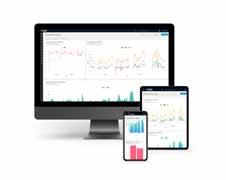
The eBook identifies four categories of process data. Feed composition statistics visualize what the machine sees, giving a good view of the nature and quality of the products or materials in the infeed stream. Material distribution statistics visualize the distribution of material on the machine over time, monitoring whether machines and processes are running optimally. Sorting statistics visualize the sorting fractions, serving as a powerful tool for quality
management and helping to match product characteristics to customer requirements. And machine health data provides information about the machine’s operational status and condition, preventing unnecessary downtime.
This deep mine of information is accessible and actionable through TOMRA Insight, the cloud-based data platform available to TOMRA machine users as a subscription-based service. The eBook explains how digital sorting data gathered by TOMRA Insight is secure - and how, by putting this data to good use, sorting can be transformed from an operational process into a valuable strategic management tool. ‘When Sorters Become Data Generating Machines’ is downloadable here free-of-charge.
About TOMRA Mining
TOMRA Mining designs and manufactures sensor-based sorting technologies for the global mineral processing and mining industries.
As the world market leader in sensorbased ore sorting, TOMRA is responsible for developing and engineering cutting-edge technology made to withstand harsh mining environments. TOMRA maintains its rigorous focus on quality and future-oriented thinking with technology tailor-made for mining.
About TOMRA
TOMRA was founded on an innovation in 1972 that began with the design, manufacturing and sale of reverse vending machines (RVMs) for automated collection of used beverage containers. Today TOMRA provides technologyled solutions that enable the circular economy with advanced collection and sorting systems that optimize resource recovery and minimize waste in the food, recycling and, mining industries and is committed to building a more sustainable future.
TOMRA has ~100,000 installations in over 80 markets worldwide and had total revenues of ~10.9 billion NOK in 2021. The Group employs ~4,600 globally and is publicly listed on the Oslo Stock Exchange (OSE: TOM). For further information about TOMRA, please see www. tomra.com
For more information on TOMRA Mining visit www.tomra.com/mining or follow us on LinkedIn, Twitter or Facebook.
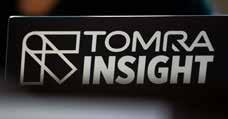
48 Mining Business Africa | January - February 2023
TOMRA
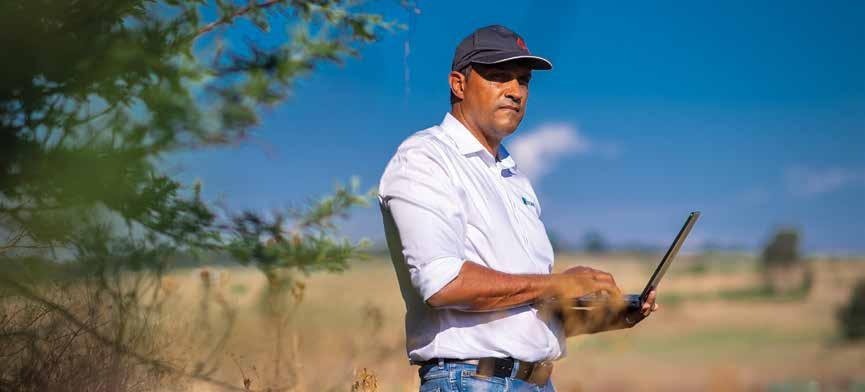
When it comes to efficiency, information is key. TOMRA Insight is a cloud-based data platform turning your sorters into connected devices and allowing you to: • Make effective, fact-based decisions using accurate reports • Reduce downtime with remote support • Stay connected to your operations company-wide • Securely access your data anywhere, anytime www.tomra.com/insight #EveryByteCounts Connect to Possibilities with TOMRA INSIGHT Learn more about TOMRA INSIGHT Download our free eBook
Gamma activation analysis Gamma activation analysis of gold-bearing ores
1 600 000 ore samples per year.
The GAA laboratory in Uzbekistan, equipped with two GAA units, has been in operation for 45 years. It is located in a 3-storey building: on the third floor, containers with samples are loaded into a vertical channel, on the second floor samples are irradiated with a linear electron accelerator, and on the first floor, the induced activity is read with a two-channel spectrometer.
This design stems from the need to reduce the level of background radiation (that appears due to scattered radiation in transport channels where containers with samples are transferred) to permissible values, safe for the personnel.
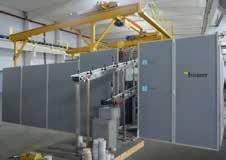
removal from the accelerator.
Fig. 1 shows the facility with a safety fence; the loading and unloading conveyors are visible. At any point in the safety fence, a dose rate of less than 1 mSv/h is provided. The facility operates in fully automatic mode.
Gamma-ray activation analysis (GAA) has great potential to replace the traditional assay analysis in gold mining, in the future. The essence of the method is the irradiation of ore samples with high-energy gamma quanta generated by a linear accelerator (LINAC), and recording the induced activity of excited gold nuclei by a gamma spectrometer. Main advantages of the GAA method in determining the gold content in ores are as follows:
• The high penetrating power of the accelerator’s gamma radiation with a maximum energy of about 8 MeV allows the analysis of samples of large volume, which eliminates the need for fine grinding of the sample material and significantly increases the representativeness of the analysis.

• Sample analysis time is less than 1 minute.
• Residual induced activity is practically absent, since the half-life of excited gold nuclei is approximately 7.5 seconds.
• The sample material is not destroyed during the analysis, the samples can be analyzed repeatedly and stored to confirm the measurement results.
• The GAA system can be configured to measure elements other than gold, such as silver.
Actually, the GAA method itself was proposed more than 60 years ago, but the first three industrial GAA laboratories first appeared in the Soviet Union in the 70’s of the last century. The experience of operation of these three industrial laboratories showed the uniqueness of the GAA method for analyzing ore samples in the extraction of gold, as well as other precious metals and related elements. To date, of these three laboratories, only the Uzbekistan GAA laboratory (at Muruntau gold deposit) is operating, providing measurement of more than
The “Au-isomer” GAA facility for gold analysis [1] is a continuation and development of those technical solutions that have proven their effectiveness and reliability over many years of applying the GAA method in industrial conditions of gold mines. It has a portable design, owing to the use of a collapsible radiation shield, made of iron. The radiation shield consists of iron blocks weighing no more than 2.4 tons. To assemble the shield, the crane that is part of the facility, is used. For the maintenance of the accelerator, 5 rear shield blocks are removed and the accelerator is wheeled out of the radiation shield. This procedure takes no more than 20 minutes. The facility is mobile: it can be disassembled, if necessary, and moved to another location in several 20’ and 40’ footers. The required time for disassembly and assembly of the facility is 2 and 3 weeks, respectively.
“Au-Isomer” uses the same scheme for moving containers with samples and the same irradiation scheme as in the installations at the Muruntau mine (Uzbekistan). The movement of containers with samples under the force of gravity ensures reliable uninterrupted operation due to the simplicity of the design. Sample containers are round, 45 mm thick, and have a diameter of 110 mm. They are irradiated from the side while rotating, which ensures the uniformity of the absorbed dose of hard gamma radiation by the container’s volume. However, in the “Au-isomer” facility, all equipment is located in a single-storey premises. Owing to the curvature of transport channels and the installation of two fast lead shatters in them, we were able to place the entire structure within a 230 cm high iron radiation shield. The facility has dimensions of 7.1 x 4.5 m and a height of 4.1 m together with a crane designed for the assembly and disassembly of radiation shield (fig. 1). Outside the facility, in separate rooms, there are power supplies of the accelerator and a cooler for heat
A diagram of the facility is shown in fig. 2. Containers with ore samples (300 ml volume) are weighed and marked with a bar code, and then placed on the loading conveyor 2 of the Sample Transportation System 1. At the end of the conveyor 3, the containers stop for reading of their barcode, and then roll down channel 4 to the electron accelerator’s target 5. During irradiation, the containers are rotated by drive 6 to ensure uniformity of dose distribution in the container volume. Channels 4 and 7, like the electron accelerator, are surrounded by radiation shielding. After irradiation, the containers roll down channel 7 to the spectrometers 8 of the Registration System to measure the spectrum of induced activity. After measurement, the containers are lifted by a lifting mechanism 9 for unloading onto the container return conveyor 10, or loading into channel 4 for re-irradiation. The decision to re-irradiate is carried out by the Transportation System control program, which contacts with the signal processing program of the Measuring System if there are not enough statistics (i.e., when the level of signal in the energy irradiation zone of the “Au-isomer” is low). Containers measured a second time will alternate in channels 4 and 7 with containers measured the first time, and the container barcode reading system at the entrance to channel 4 will inform the computer control system about which container went to irradiation.
The time limit regulations of the GAA facility operations for gold are as follows: reading the barcode – 3 sec, moving the container to the irradiation zone after reading the barcode – 2 sec; irradiation – 10 sec; moving the container to the detectors of the Registration System after irradiation – 2 sec; measurement – 15 sec;
50 Mining Business Africa | January - February 2023 FEATURE
Fig. 1. “Au-isomer” gamma-activation analysis facility
Fig. 2. Simplified diagram of “Au-Isomer”
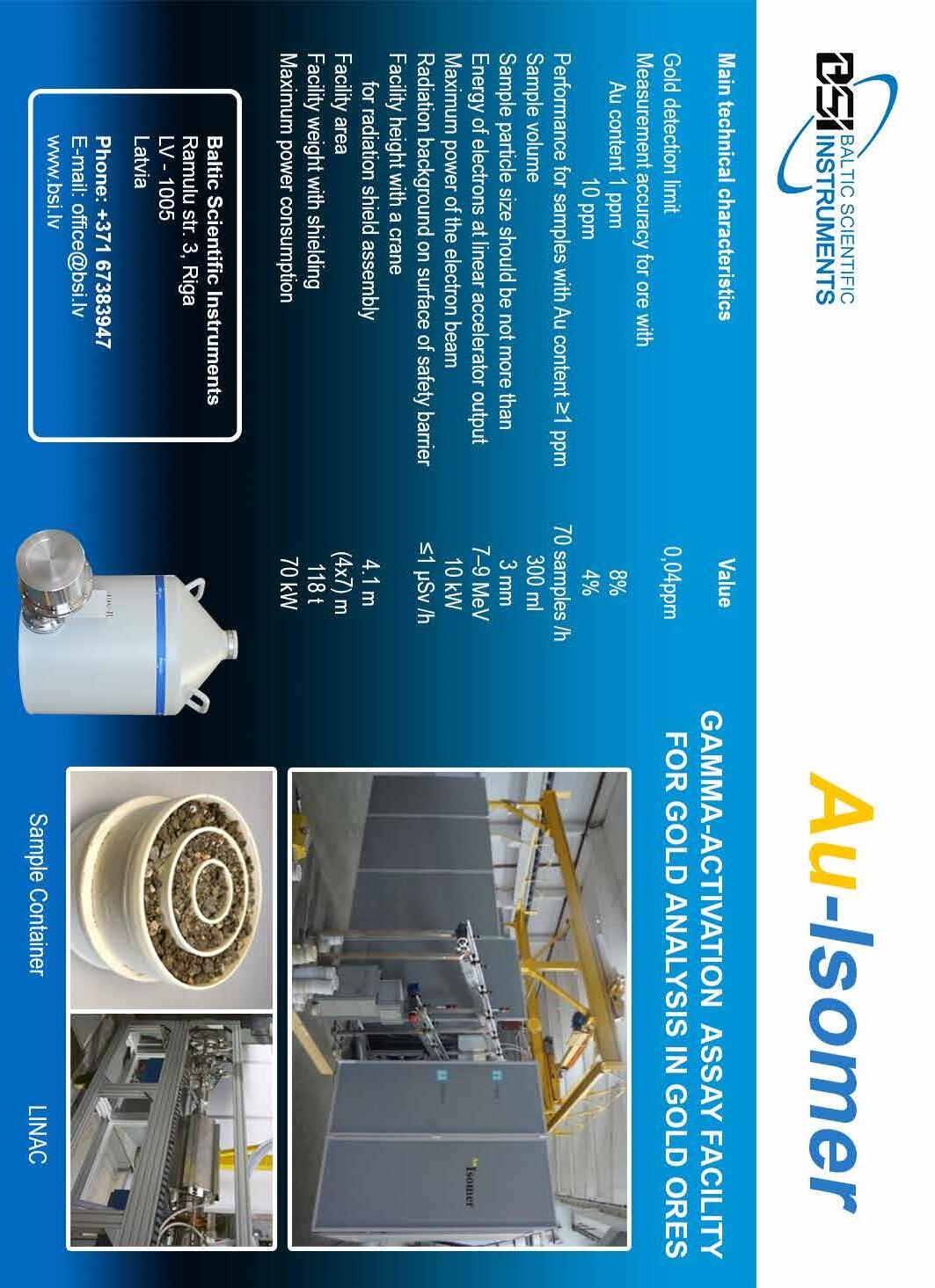
FEATURE
• Sample volume, ml 300
• Sample particle sizes shall not exceed, mm 3

• Height of the facility with crane for assembling radiation shield, m 4,1
• Width of the facility excluding cooler and klystron modulator, m 4.5
• Length of the facility, m 7
• Weight of the facility with radiation shield, t118
• Maximum power consumption, kW 70
• Electron energy at the output of the linear accelerator, MeV 7-9
• Maximum electron beam power, kW 10
• Radiation background on the surface of the fence, not more than, μSv/h 1
• Diameter of spectrometer detectors made of pure germanium, mm 110
making a decision on re-irradiation – 1 sec, unloading – 15 sec. Thus, the total time of one analysis is about 47 seconds, which provides maximum capacity with a single irradiation/ sample reading cycle of up to 76 analyzes per hour. The main characteristics of the GAA facility are shown in Table 1.
Table 1. Main technical characteristics of “Auisomer”
• Capacity for samples with a gold content of more than 0.5 g/t, sample/hour 70
References
• Energy resolution of spectrometers by energy 122 keV, eV 720-750
• Energy resolution of spectrometers by energy 662 keV, eV 1350-1390
• Number of spectrometers 2
The “Au-isomer” GAA facility provides MDA values of about (0.026-0.028) g/t with a single irradiation for 10 seconds and a spectrum acquisition time of 15 seconds [2]. For samples with a gold content of less than 0.4 g/t, we averaged 2-4 measurements. The facility
automatically directs samples for repeated measurements if there are insufficient statistics on the results of one measurement and averages the results of several measurements.
On reference samples of ore certified for gold content (RS), multiple measurements were made, the results of which are captured in fig. 3. As can be seen from the graph presented, the results of RS measurements fit (with a margin) within the limits of the permissible deviation, shown by the red line.
• Baltic scientific instruments. Au-Isomer – Industrial Gold Ore Analysis. https://bsi.lv/en/products/ndt-analyzers/
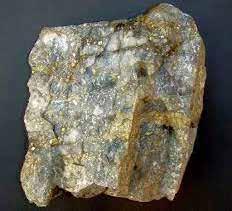
• Applied Radiation and Isotopes, Volume 182, April 2022, 110147. Improvement of metrological characteristics of a new industrial facility for goldbearing ore gamma activation analysis. https://doi.org/10.1016/j.apradiso.2022.110147
Advertiser’s index
Mining Business Africa (MBA) is Pan-African bi-monthly publication that focuses on latest developments in mining and allied industries in Africa. The publication covers the scope of critical activities from pit to port – mineral exploration (prospecting), mine planning and development, extraction, mineral processing, storage transportation, as well as beneficiation.
Mining Business Africa provides the desired mileage for companies looking to promote their products and services to a specific niche clientele in the African Mining Sector. Subscribers are located or at least involved in projects in South Africa, Botswana, Zimbabwe, Zambia, Kenya, Democratic Republic of Congo, Kenya, Tanzania, Ghana and Nigeria.
MBA is published by Media Icon, a company manned by personnel with a combined experience of 30 years in the publishing space.
Fig. 3. The results of measuring the gold content in reference samples and the limits of permissible deviation
African Reptiles and Venom.................................................21 Becker Mining.........................................................................47 BSI............................................................................................51 C Track.....................................................................................46 Carl Hamm PPS.....................................................................36 Corflex Engineering (Pty) Ltd................................................05 Economic Development Solutions (EDS)............................35 Eriez..........................................................................................24 HYVE Group.........................................................................IFC i- CAT International.............................................................OBC Itoo Special Risks (Pty) Ltd...................................................25 knight
Nel Hydrogen..........................................................................43 Optibelt GmbH........................................................................33 PDAC.......................................................................................44 Probe IMT
Resources
Risk Insights Pty ltd................................................................06 SAIPEC.....................................................................................29 Spill Doctor..............................................................................13 Tomra.......................................................................................49 Vac-cent
Vibramech...............................................................................18 Wearcheck
Weber Mining...........................................................................17
Piesold..........................................................................43 MHS Plant and Equipment....................................................39 Mineware Consulting.............................................................41
Group....................................................................10
4 Africa...............................................................IBC
Services (Pty) Ltd..................................................15
Pty Ltd.................................................................28
TO ADVERTISE | CALL: + 27 10 055 3356 | Email: info@miningbusinessafrica.co.za
FOR PRODUCERS, INVESTORS AND USERS OF PLATINUM GROUP METALS
PGMs Industry Day | 28 March 2023
Country Club Johannesburg, Auckland Park & online
Resources for Africa is pleased to announce its sixth annual PGMs Industry Day taking place on Tuesday 28 March 2023 in Johannesburg. Key stakeholders including PGMs producers, users and investors will take an open, honest and frank approach to tackling the key issues facing the PGMs sector in the coming years. Early confirmed speakers include:
Nico Muller, CEO, Impala Platinum
Natascha Viljoen, CEO, Anglo American Platinum
Phoevos Pouroulis, CEO, Tharisa Minerals
Bernhard Fuchs, Senior Vice President Precious Metals Management, Umicore AG
Timothy Ingle, Senior Vice President, Precious Metal Services & Recycling, BASF
Henk de Hoop, CEO, SFA Oxford
Roger Baxter, CEO, Minerals Council South Africa
And many more…
Key topics to be discussed include:
• Trends in the PGMs sector and strategies of producers
• Current geo-political and economic realities and impacts
• The role of PGMs in the energy transition and the road to net zero carbon emissions
• PGMs and the transformation of the automotive industry - combustion engines vs fuel cell EVs vs battery EVs
• Supply, demand and future projections
• Market development and applications for the future
• Investors and funders – the latest views
• Recycling, recovery and reprocessing
• Beneficiation opportunities
• The role of PGMs in the hydrogen economy
• And much more…
Contact us about sponsorship opportunities: sponsorship@resources4africa.com REGISTER NOW! +27 (0) 11 463 7799 // +27 (0) 61 421 9492 registrations@resources4africa.com // www.pgmsindaba.com
STRATEGIES FOR A LONG-TERM, SUSTAINABLE INDUSTRY
The organisers retain the right to amend the programme, content, timings and speakers. © Resources For Africa Investment Conferences (PTY) Limited The PGMs Industry Day is sponsored by: Lead Sponsor Sponsors Mining Industry Partners
Lead Sponsor
LOCALISED SUPPRESSION

ROTO-FIRE PAC®
BLAZE BUSTER®
CONVEYOR BELT
LOCALISED

SUPPRESSION
VEHICLE
I-PROTECT® FOAM & WATER MIST
ARMOURED VEHICLES
BLAZE BUSTER
ROTO-FIRE PAC®
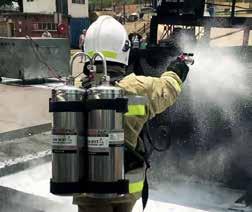
CONVEYOR BELT

ROTO-FIRE CONVEYOR BELT VEHICLE






















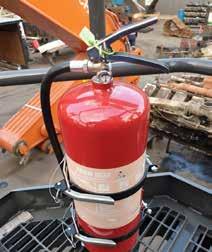
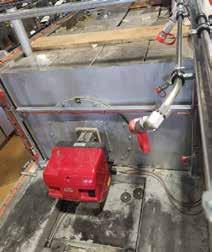

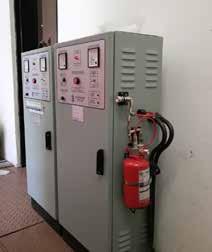
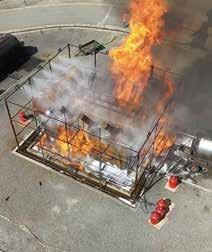

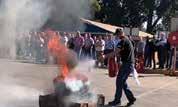



CONVE ARMOURED VEHICLES I-PROTECT® WATER MIST C A T .C O F I RE S U P P RESSI O N S YSTEM S
ROTO-FIRE PAC®
BLAZE BUSTER®
WW W . I - C A T .C O
SYSTEMS F I RE S U P P RESSI O N S YSTEM S
I-PROTECT
VEHICLE I-PROTECT® FIRE SUPPRESSION






























































































































































 By: Michelle Murray
By: Michelle Murray























































